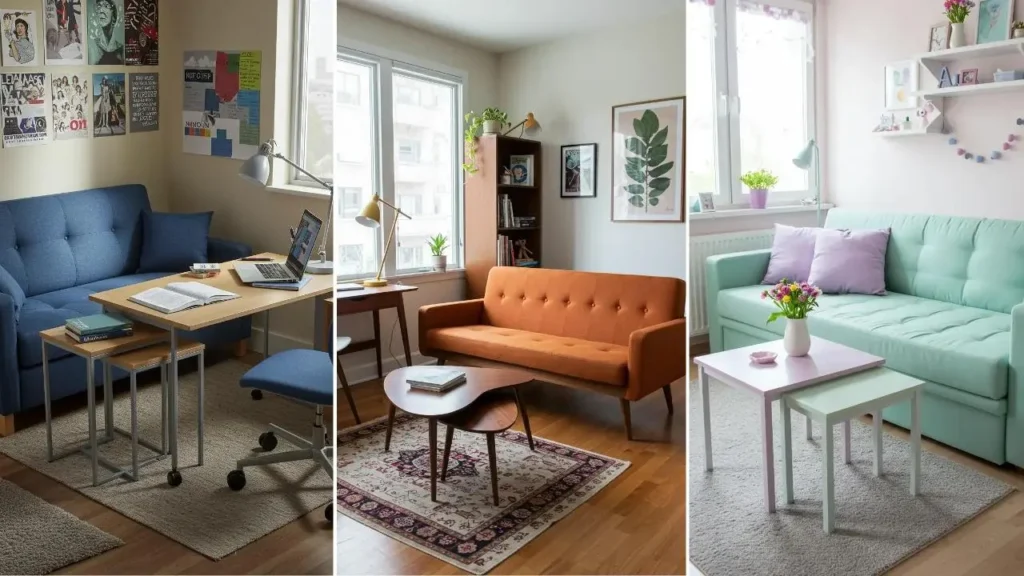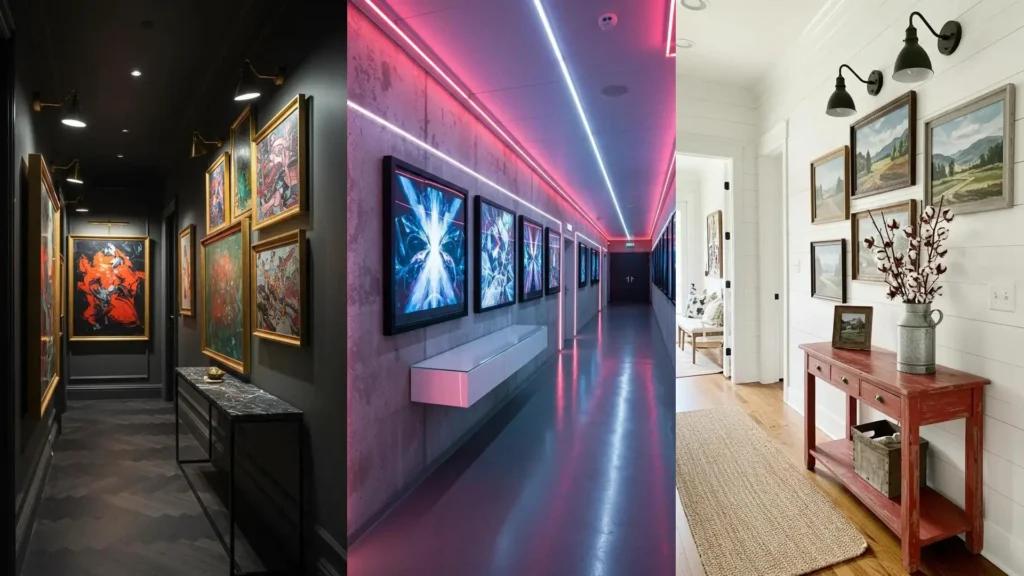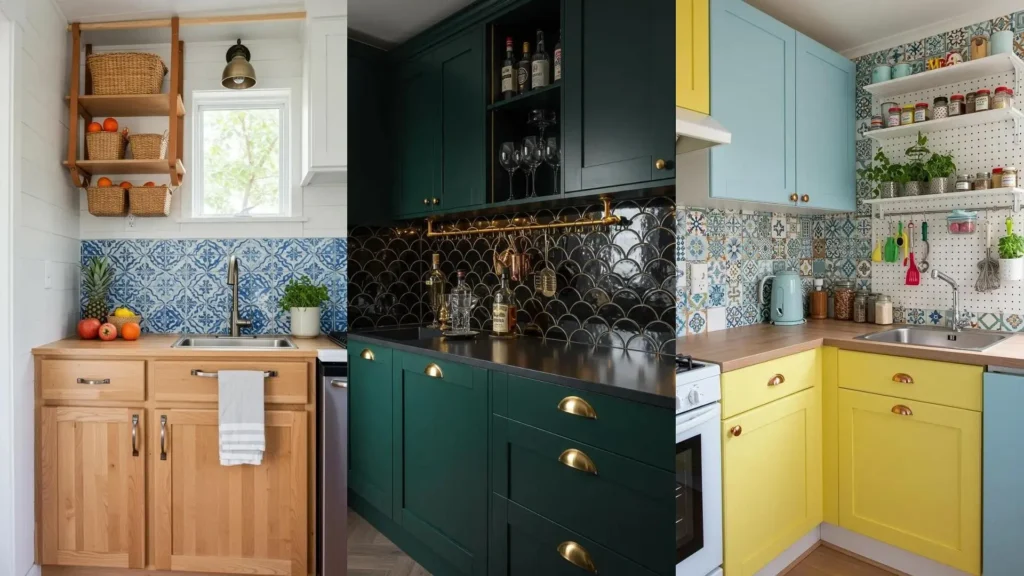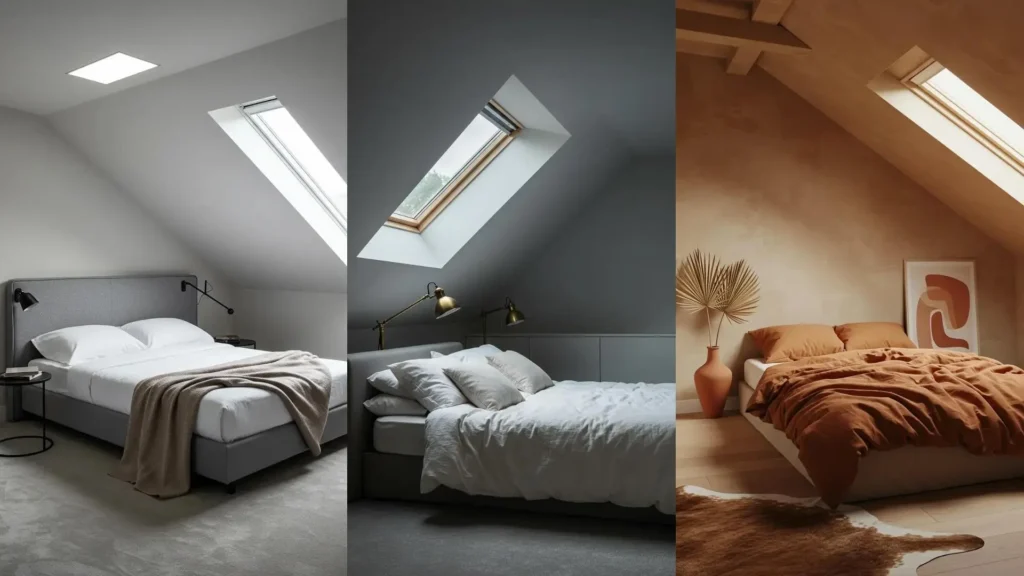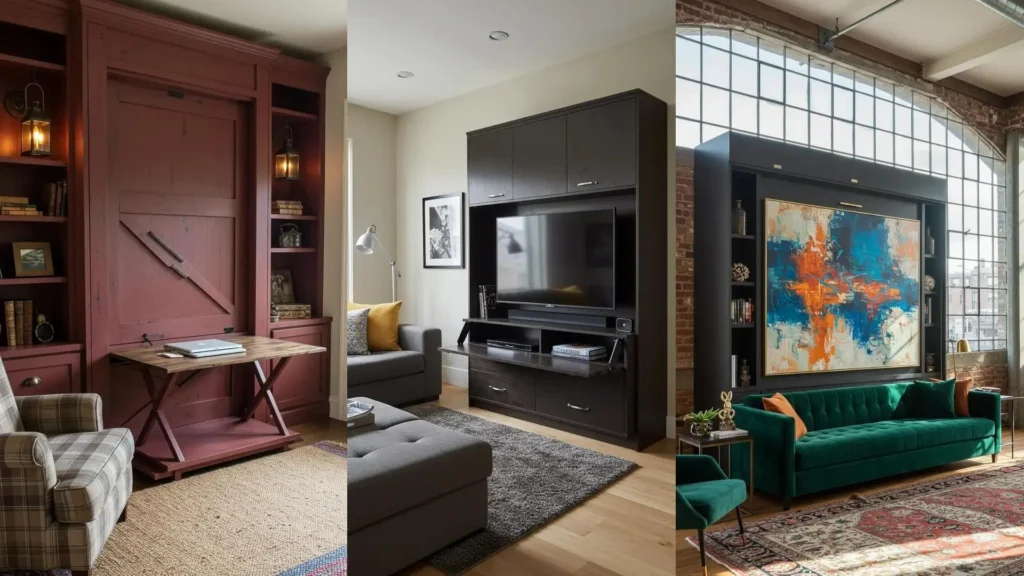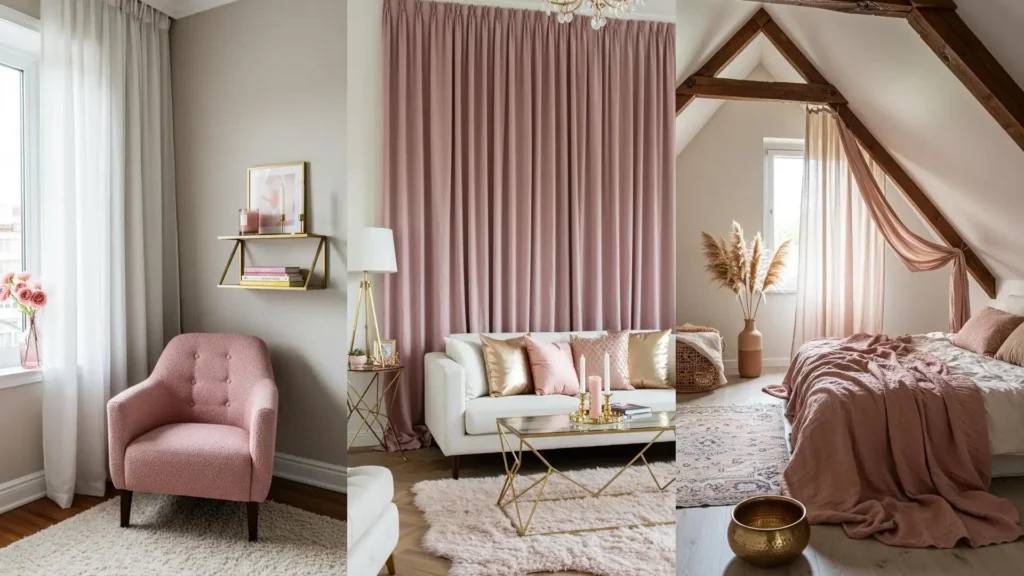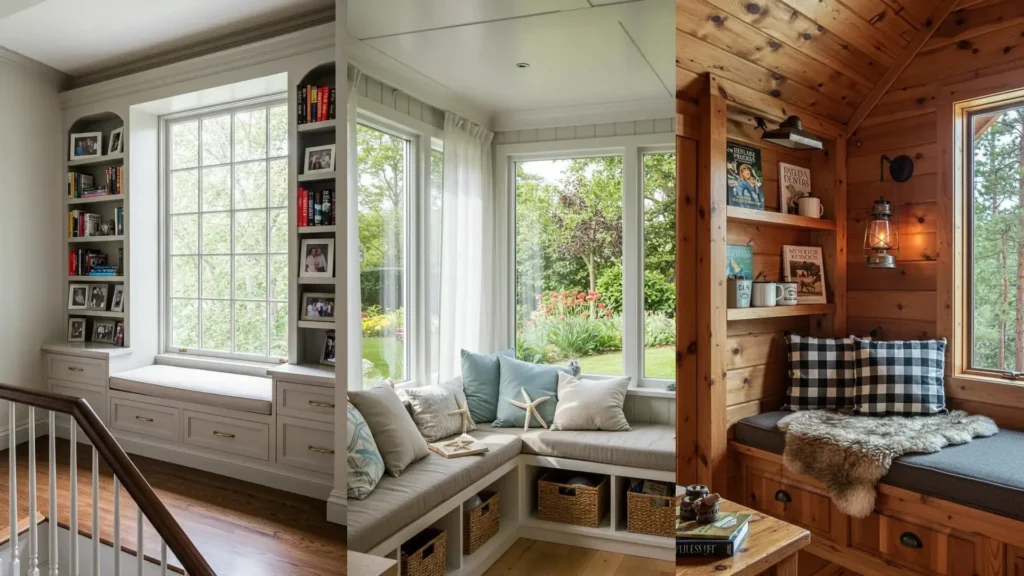When you live in a smaller space, every single choice matters. It’s not about having less; it’s about making the things you have work harder, smarter, and more beautifully for you.
The key isn’t to find the one perfect layout, but to embrace flexibility. Your home needs to be a living room, an office, a dining area, and a quiet retreat—sometimes all in the same day.
Here, we’ll explore how to use versatile, intelligent pieces like sleeper sofas, nesting tables, and mobile desks to create a space that adapts to your needs. This is how you build a home that feels not just organized, but also deeply personal and serene.
1. The Corner Office That Disappears
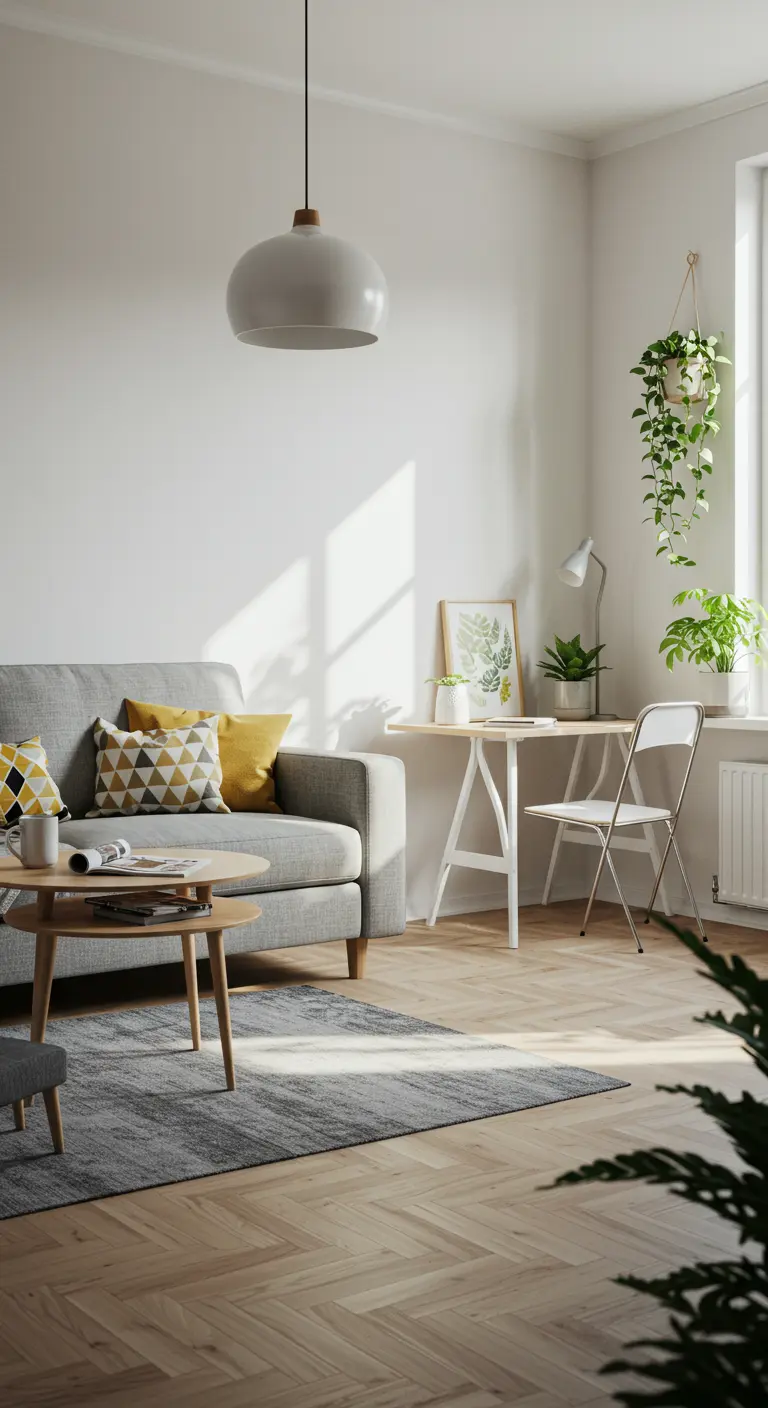
Create a distinct work zone that feels intentional, not intrusive.
Place a slim, trestle-style desk by a window to borrow natural light, which makes any task feel less like a chore.
Pair it with a simple folding chair you can hang on a wall hook when not in use. This frees up the visual and physical space, allowing your living room to reclaim its identity after the workday is done.
A low-slung pendant light over the coffee table firmly anchors the lounge area as the room’s primary focus.
2. The Night-Mode Transformation

Your space needs to work for you around the clock, and the transition should be effortless.
Here, the sleeper sofa converts the living room into a serene guest space.
A mobile, C-shaped desk is the hero piece: by day, it’s a workstation; by night, it slides over the bed to become a perfect stand for a laptop or a late-night cup of tea.
Warm, low-level lighting from task lamps creates an intimate mood, signaling that it’s time to unwind.
3. The Industrial Loft’s Softened Edge
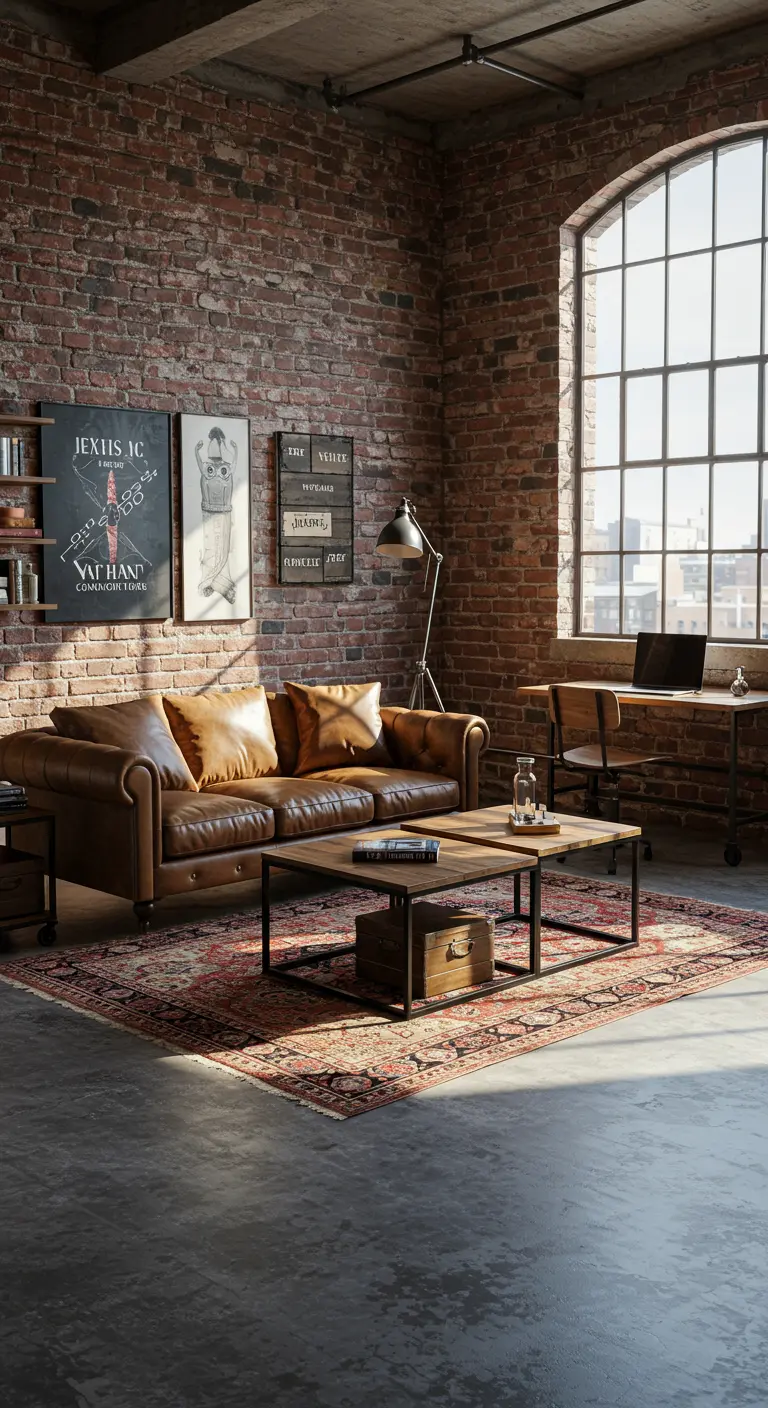
In a space with strong architectural elements like exposed brick, choose furniture that complements, not competes.
A cognac leather sofa adds warmth and a lived-in feel, while its low profile keeps the sightlines open to the large window.
Introduce nesting coffee tables to provide flexible surface area; you can cluster them for a layered look or separate them to serve guests.
A mobile desk on casters allows you to create a workspace anywhere, then roll it aside to maintain the open, airy feeling of the loft.
4. The Calming Effect of Vertical Lines
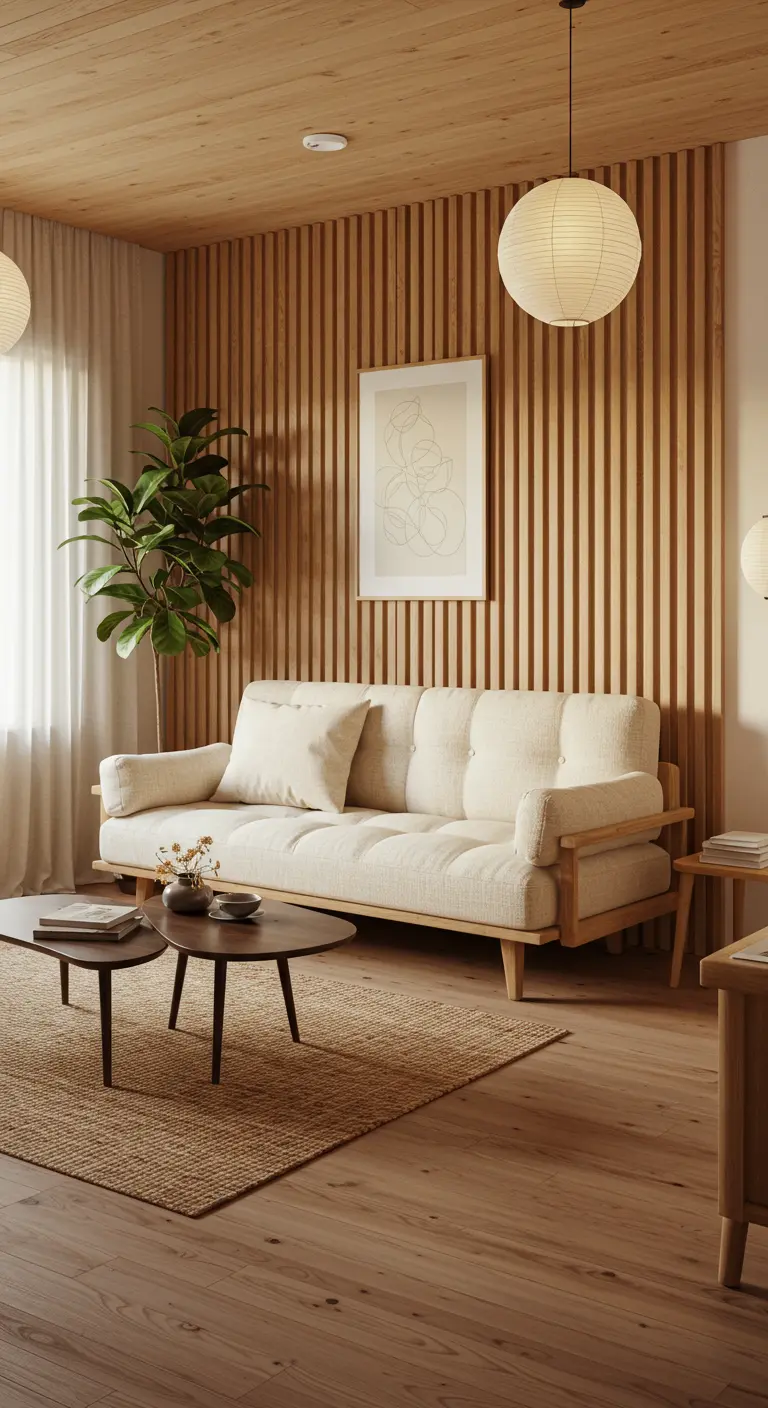
To make a room feel taller and more serene, use vertical wood slats as an accent wall.
This technique draws the eye upward and adds incredible texture and warmth, eliminating the need for much else on the wall.
Choose a sofa with a simple, clean-lined wood frame to echo the wall treatment. This Scandinavian approach celebrates natural materials and uncluttered surfaces, which instantly makes a small space feel more breathable.
Organic-shaped nesting tables continue the soft, nature-inspired theme.
5. The Bohemian Edit: Layered & Lived-In
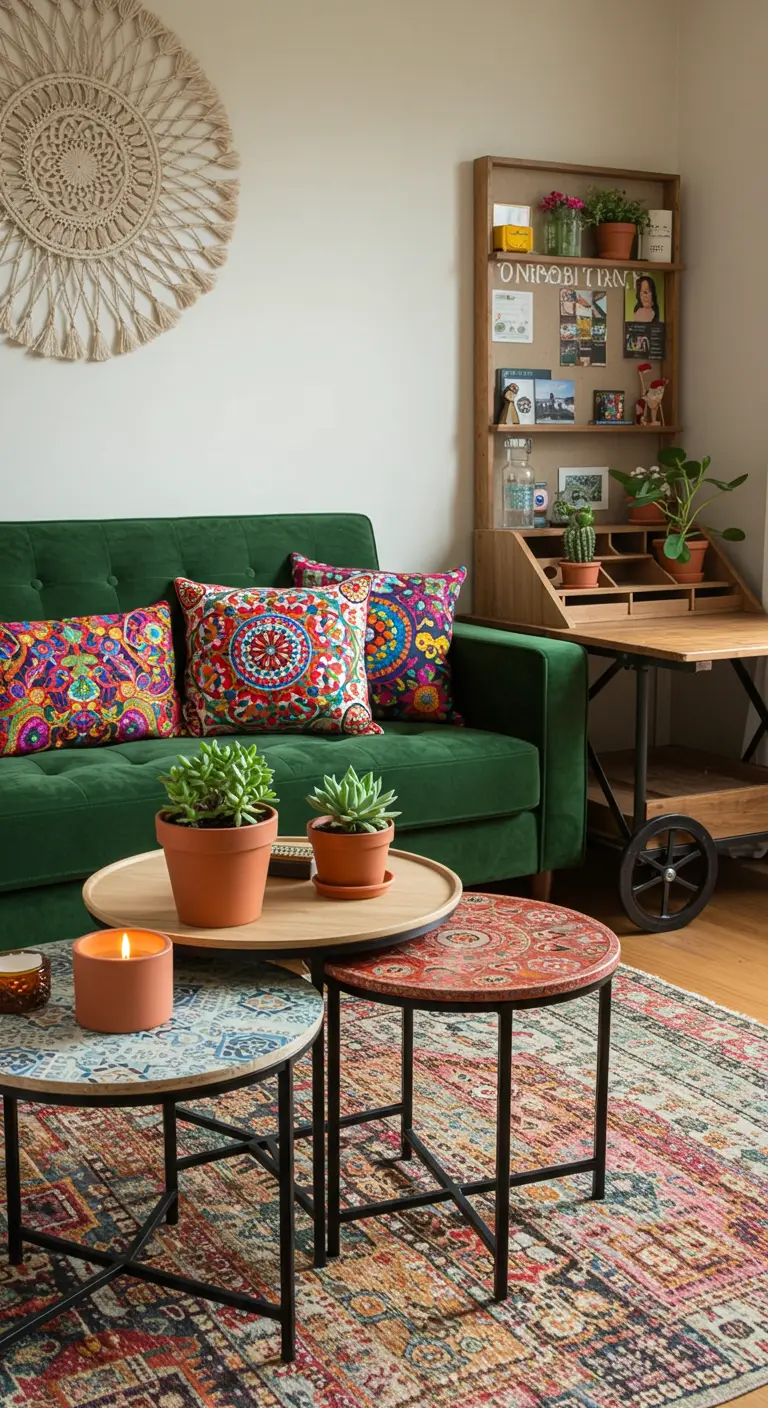
Embrace color and pattern, but do so with intention.
Start with a strong, solid-colored sofa—like this rich emerald green—as your anchor.
Then, introduce pattern through textiles and smaller furniture pieces, like these tiled nesting tables. This creates a vibrant, eclectic look that feels curated, not chaotic.
Swap a traditional desk for a mobile utility cart; it offers storage, a work surface, and character, all while being easily moved wherever you need it.
6. The Power of Transparency in Narrow Spaces

When furnishing a long, narrow room, the goal is to eliminate visual barriers.
Acrylic or lucite nesting tables are your best tool for this. They provide all the function of a coffee table but take up virtually zero visual space, allowing the eye to travel uninterrupted through the room.
This trick makes the walkway feel wider and the entire space more open.
Anchor a simple, tufted sleeper sofa against the longest wall to maximize the floor plan and create a comfortable zone that doesn’t feel squeezed.
7. The High-Contrast Minimalist Approach
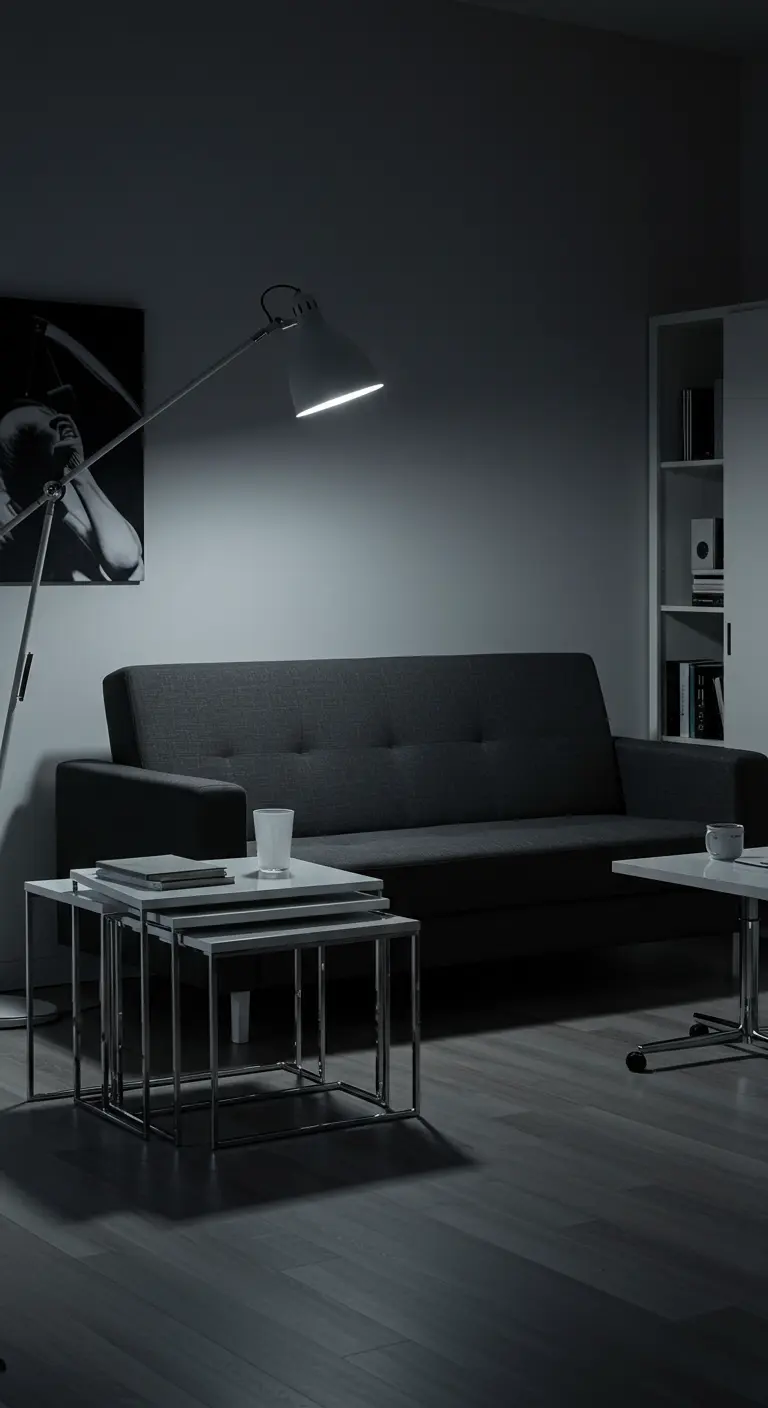
A dark, monochromatic palette can feel incredibly sophisticated, even in a small room.
The key is to introduce reflective surfaces that bounce light around.
Here, polished chrome nesting tables cut through the moody gray tones, adding a sharp, bright accent that prevents the space from feeling flat.
Position a powerful architectural floor lamp to cast a focused glow, creating a dramatic interplay of light and shadow. This is how you achieve a cozy, cocooning feel that is also chic.
8. The Ever-Adaptable Bar Cart
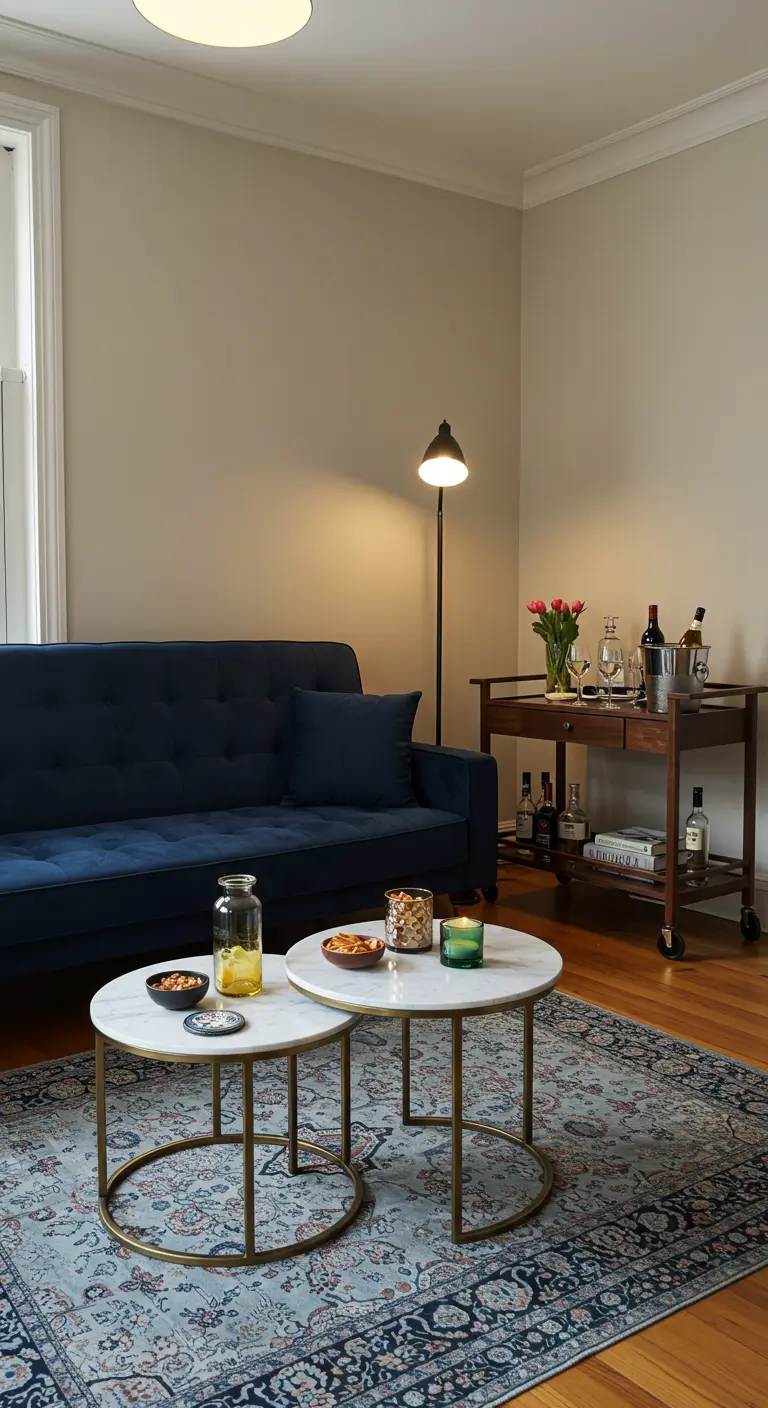
Think beyond the coffee table. A stylish bar cart on wheels offers unparalleled flexibility.
By day, it’s a handsome end table for drinks and snacks.
Need to work? Roll it over and it’s a standing desk or a perch for your laptop while you’re on the sofa.
When guests arrive, it becomes a mobile serving station. This single piece adapts to every need, freeing up your floor plan and proving that the most useful furniture is often on wheels.
9. The Mid-Century Conversation Corner
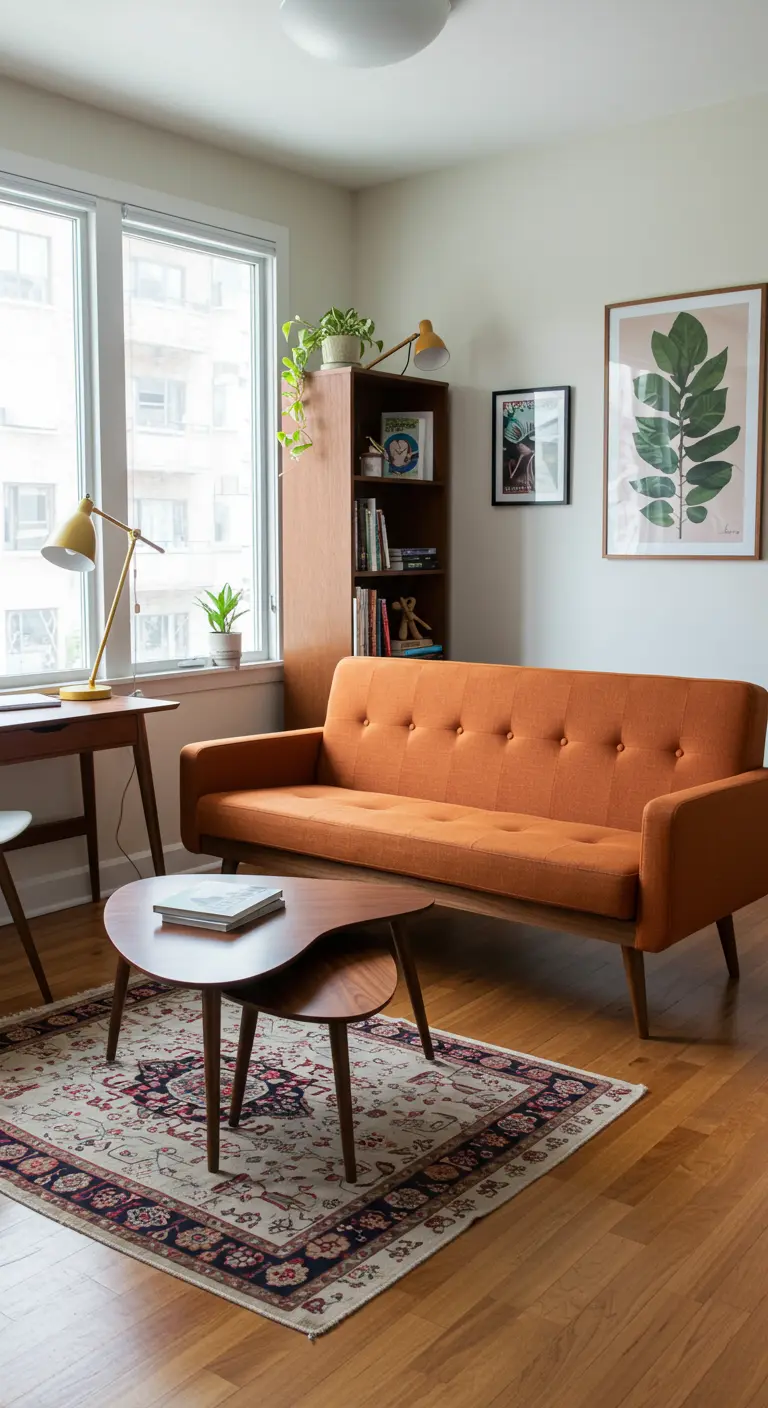
Create a cohesive and stylish vignette by pairing furniture from the same design era.
A tufted, burnt-orange sofa with tapered wooden legs sets a clear mid-century tone.
Echo that aesthetic with a kidney-bean-shaped nesting coffee table, which mirrors the organic, sculptural forms of the period.
By keeping the core pieces tonally and stylistically related, you create a polished look that feels intentionally designed. A tall, narrow bookshelf adds vertical interest without taking up much floor space.
10. The Breezy, Coastal Work-Life Balance
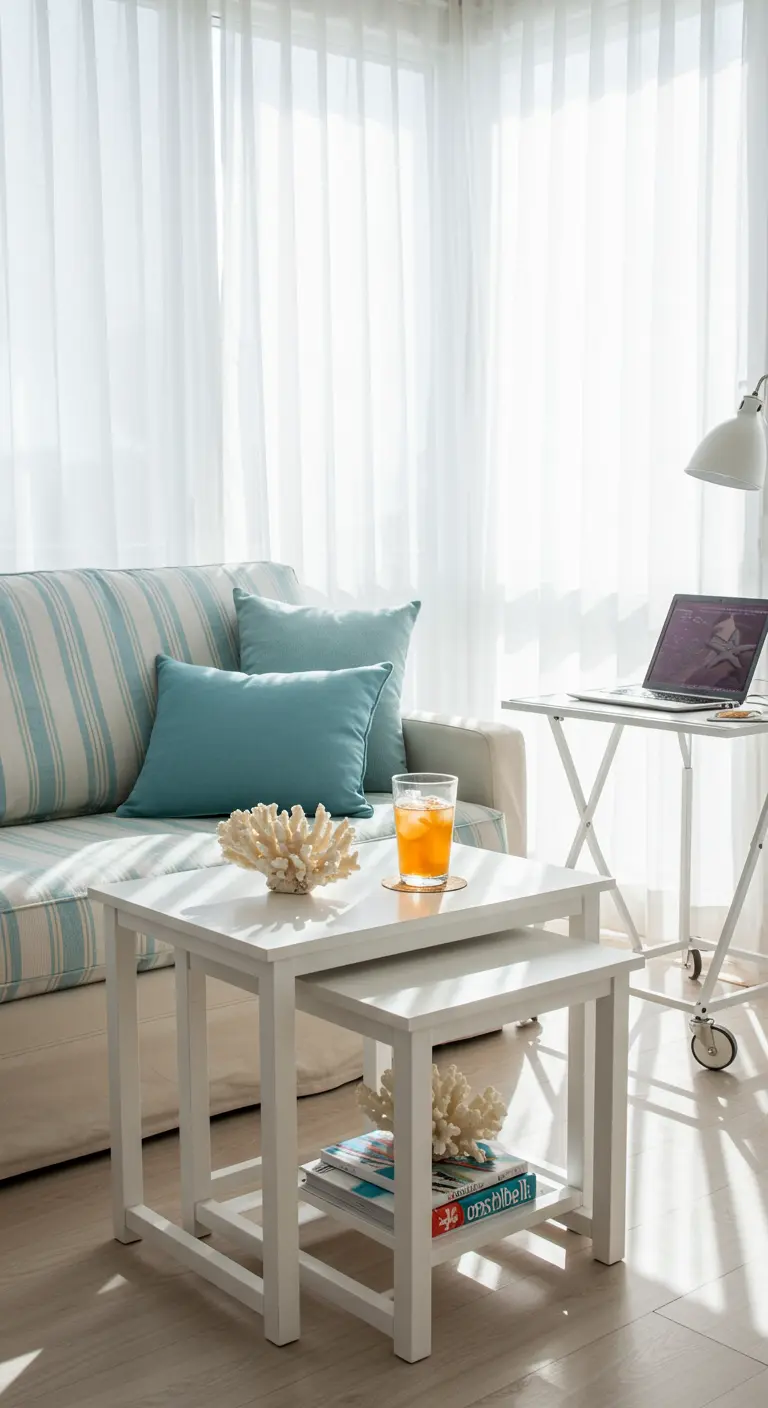
To maximize a room with abundant natural light, keep the palette airy and bright.
White nesting tables and a mobile white desk blend into the background, ensuring the focus remains on the light and the view. This is a key principle in coastal-inspired design.
A sofa with a subtle stripe adds a touch of seaside charm without overwhelming the senses.
The mobile desk can be easily rolled away, transforming the space from a functional office back into a relaxing, light-filled retreat in seconds.
11. The Open-Plan Zone Defense
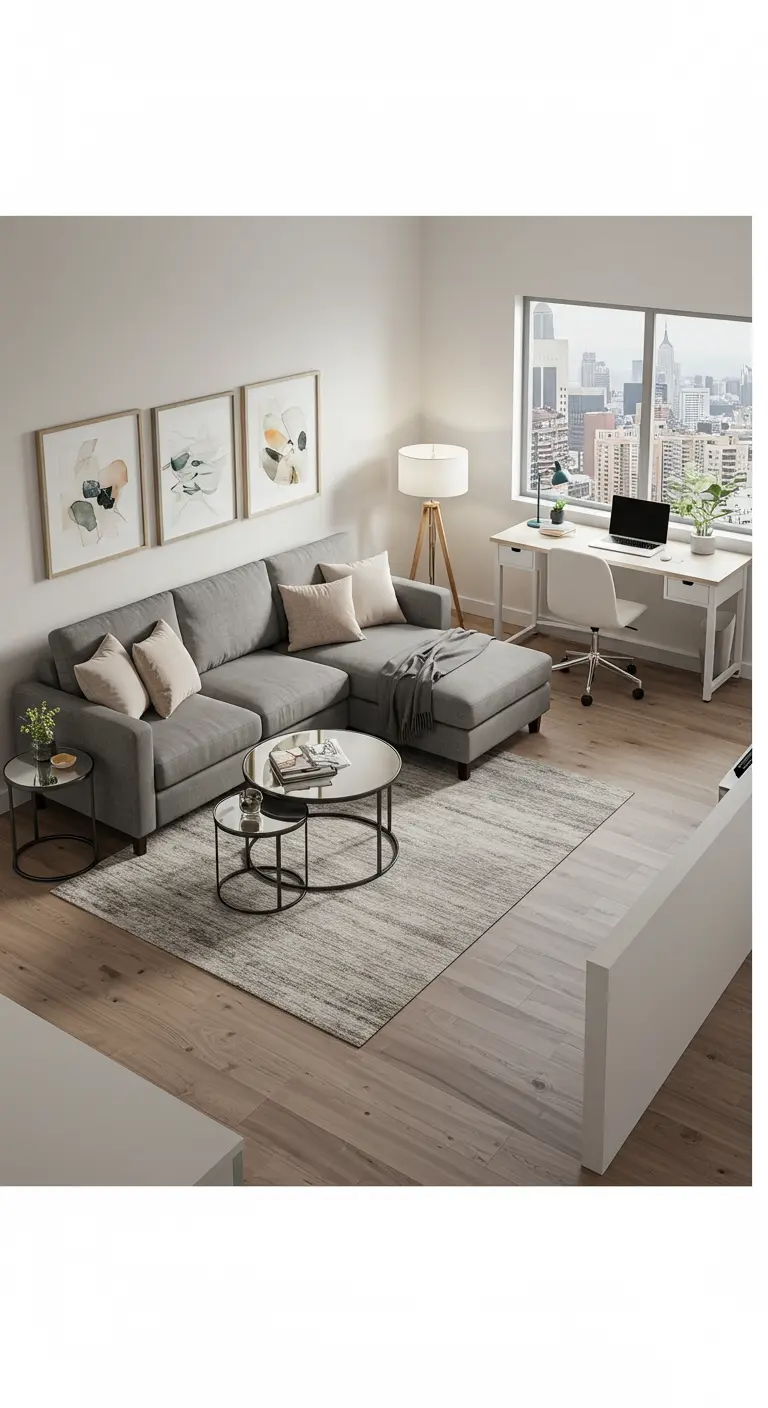
In an open-concept space, use furniture to create distinct ‘zones’ for different activities.
An L-shaped sectional sofa clearly defines the boundary of the living area, creating a cozy and contained space for relaxation.
Place a desk facing a window to establish a separate, light-filled work zone that feels psychologically removed from the lounge area.
A large, low-pile rug further solidifies the living zone, making the entire layout feel organized and intentional. This is how you create ‘rooms’ without walls.
12. The Dramatic Jewel-Box Study
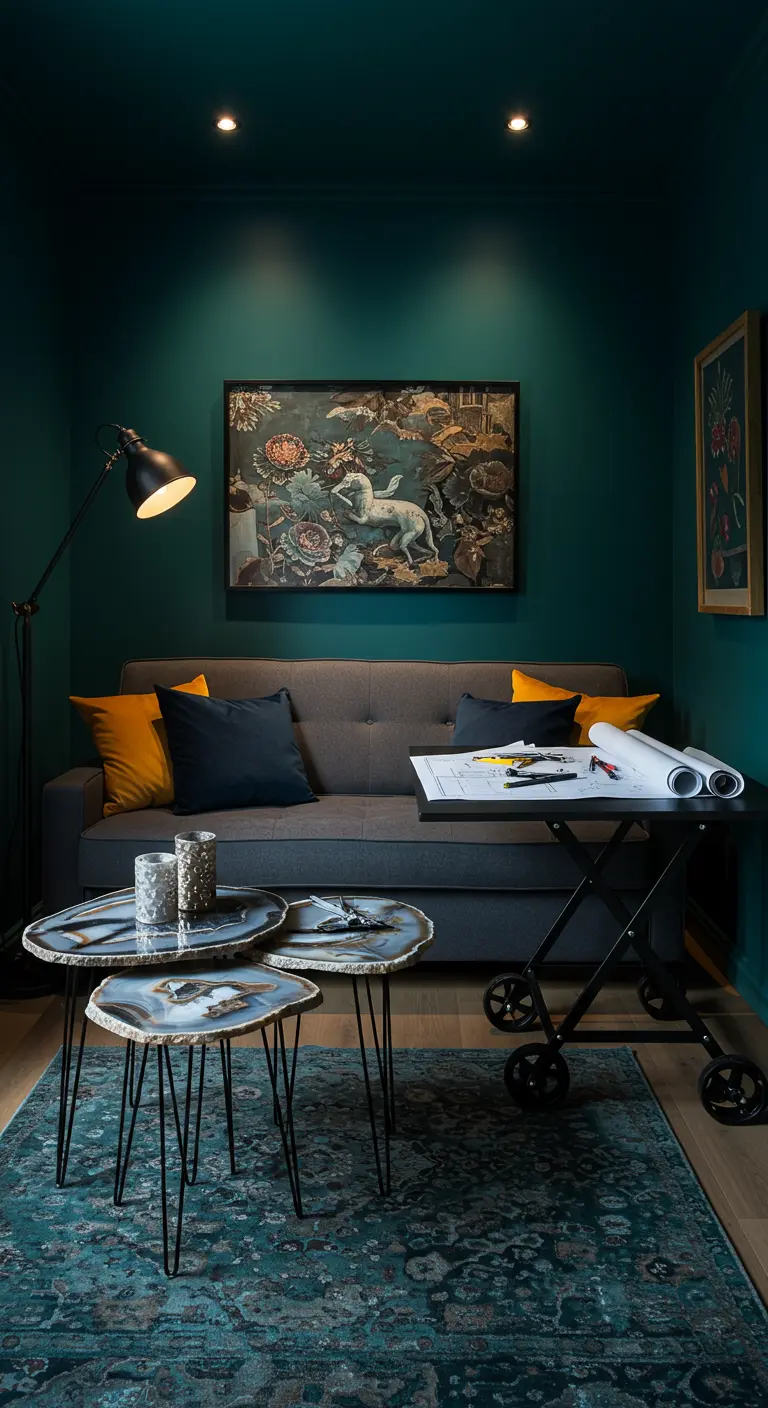
Don’t be afraid of deep, saturated color in a small space. A rich teal or emerald on the walls creates a moody, intimate atmosphere.
The key is to add moments of organic texture and light. Nesting tables with agate tops introduce a natural, geological element that feels luxurious and unique.
Use a mobile drafting-style table as your desk; its industrial lines provide a sharp contrast to the rich wall color, and its mobility makes it incredibly practical.
This approach creates a space that feels like a jewel-toned sanctuary.
13. The Glamorous & Gentle Palette
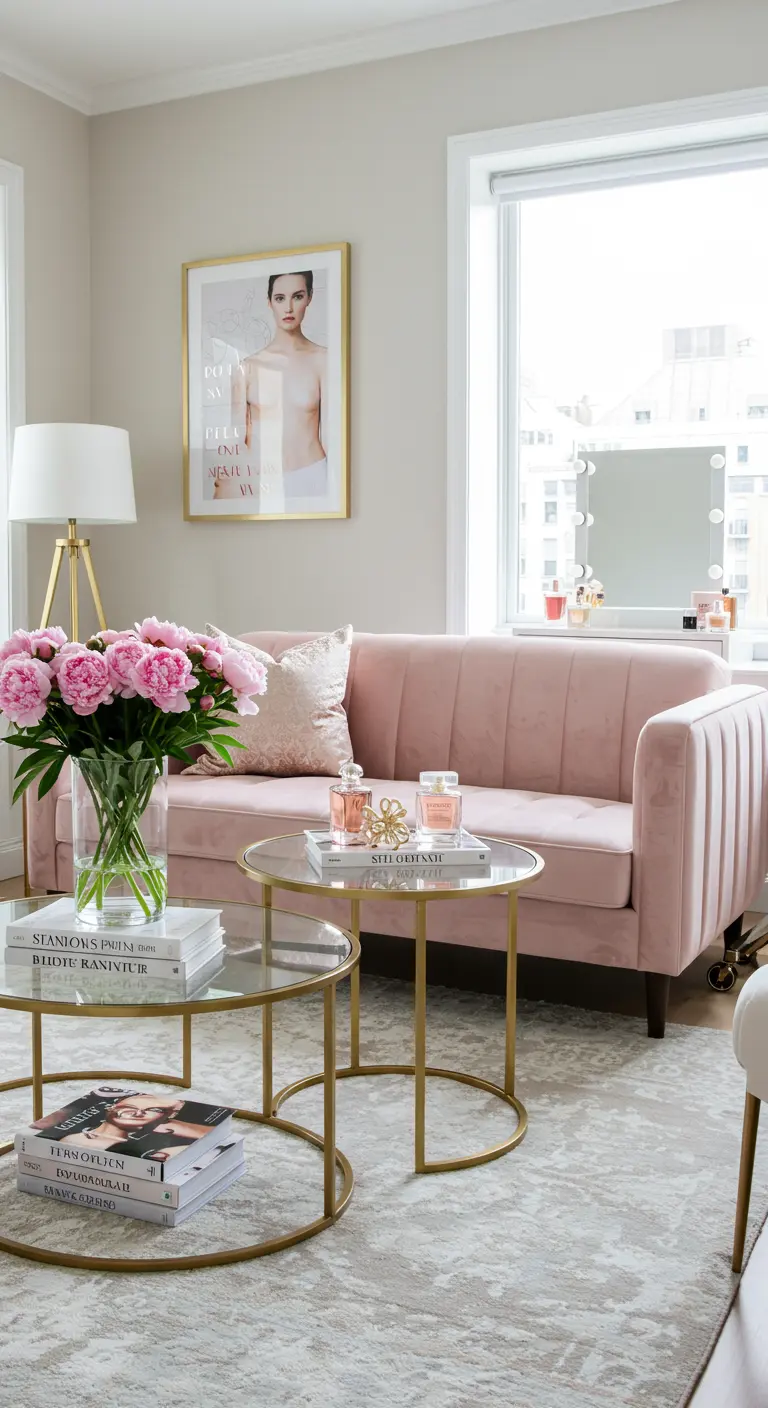
Achieve a soft, glamorous look by balancing textures and finishes.
A dusty pink velvet sofa provides a plush, inviting focal point. To keep it from feeling heavy, pair it with glass and brass nesting tables.
The transparency of the glass and the slim profile of the brass legs add a sense of lightness and airiness, a signature of luxe-glam style.
This combination feels sophisticated and feminine without sacrificing function, giving you ample surface space that feels visually light.
14. The Urban Gardener’s Workstation
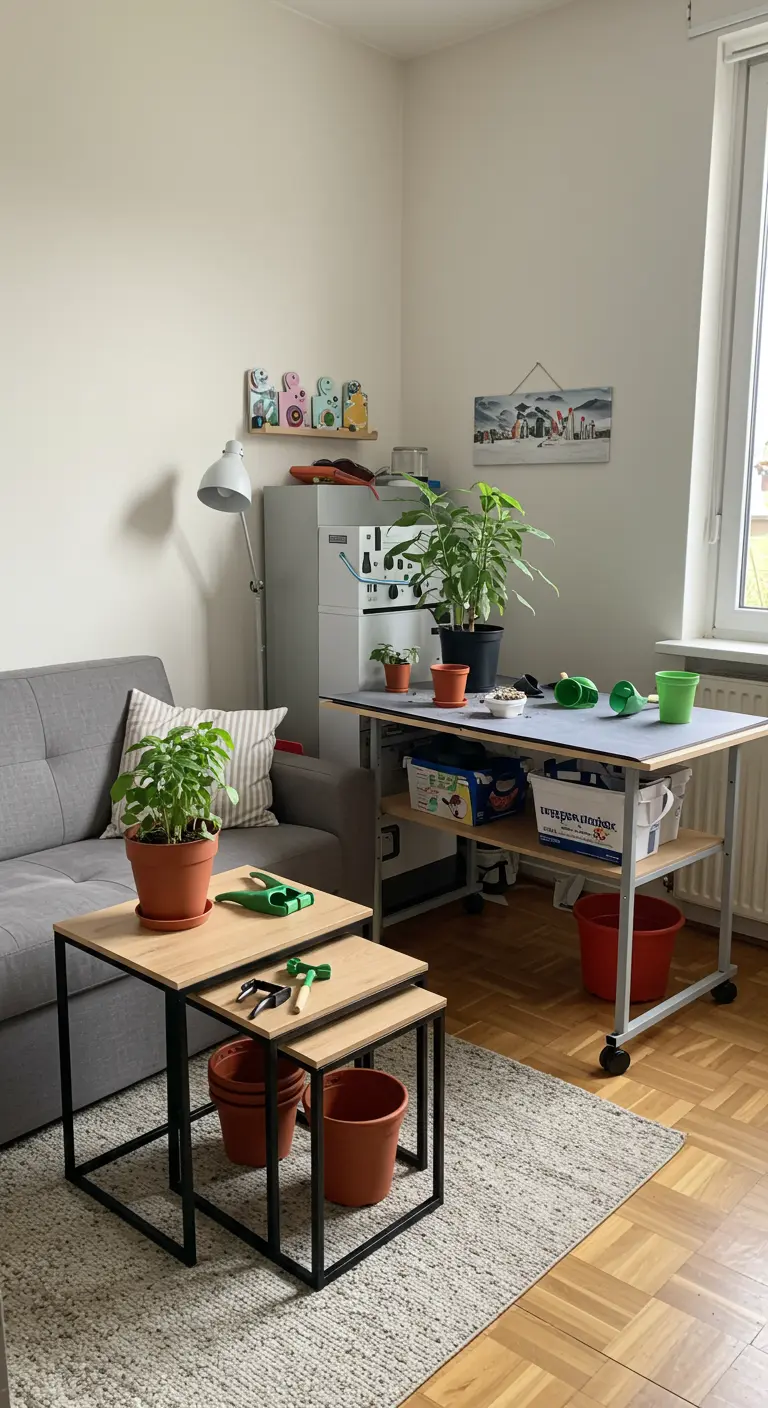
Your living space can and should support your hobbies.
Designate a corner for your passion, whether it’s gardening, painting, or crafting. A large, sturdy mobile table is the perfect foundation for a flexible hobby station.
Its shelves provide storage for supplies, and you can roll it out when you need space to work, then tuck it away neatly against a wall.
Use nesting end tables to hold tools or a drink, keeping them within reach but off your main work surface. This creates a dedicated zone that inspires creativity.
15. The Day-to-Night Dual Identity
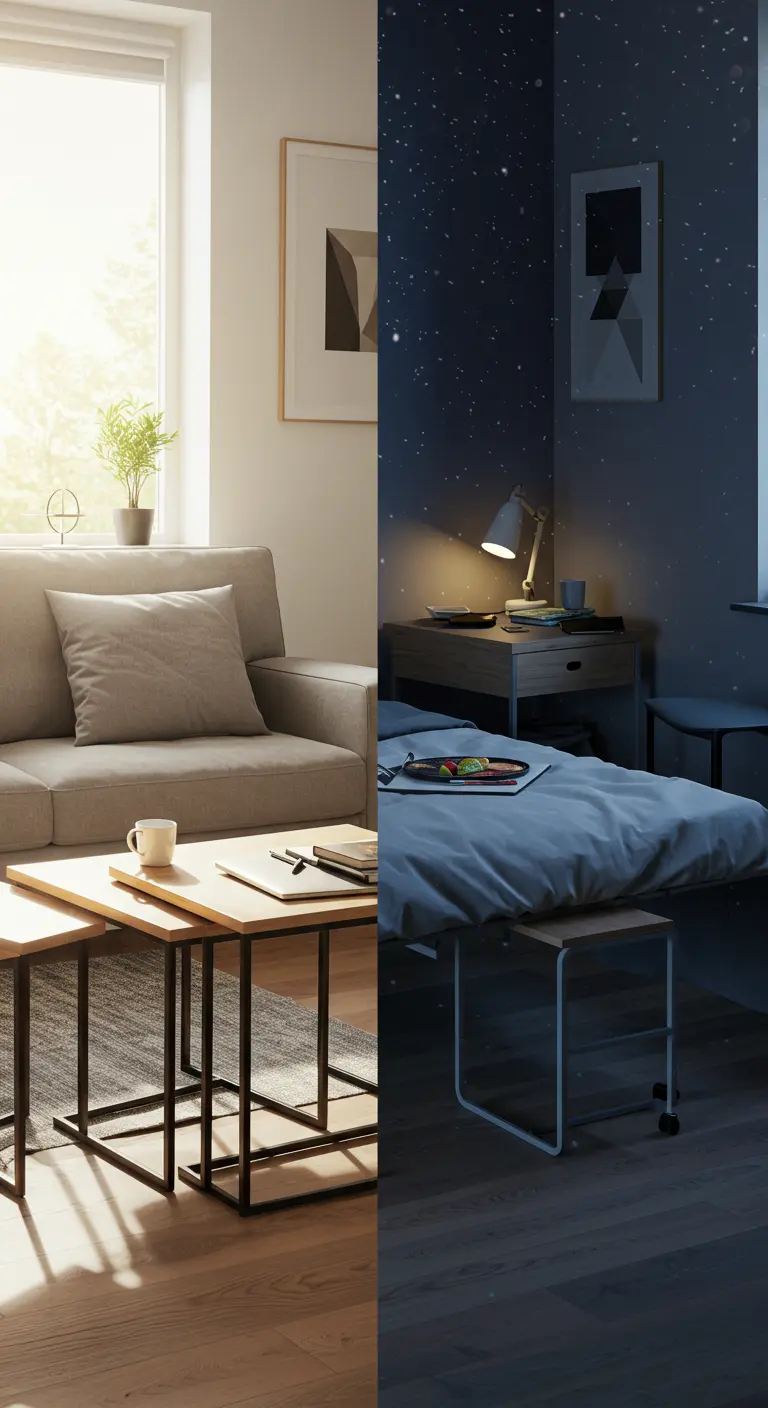
A successful studio apartment hinges on seamless transitions.
Invest in a high-quality sleeper sofa that looks as good as it feels. By day, it’s a chic, comfortable living area anchored by modern nesting tables.
By night, it transforms into a restful bedroom. The key is choosing bedside furniture that also works for the living room setup. A C-shaped table on wheels is the perfect chameleon—it can be a side table, a laptop desk, or a nightstand.
16. The Art of Defining Space with Rugs
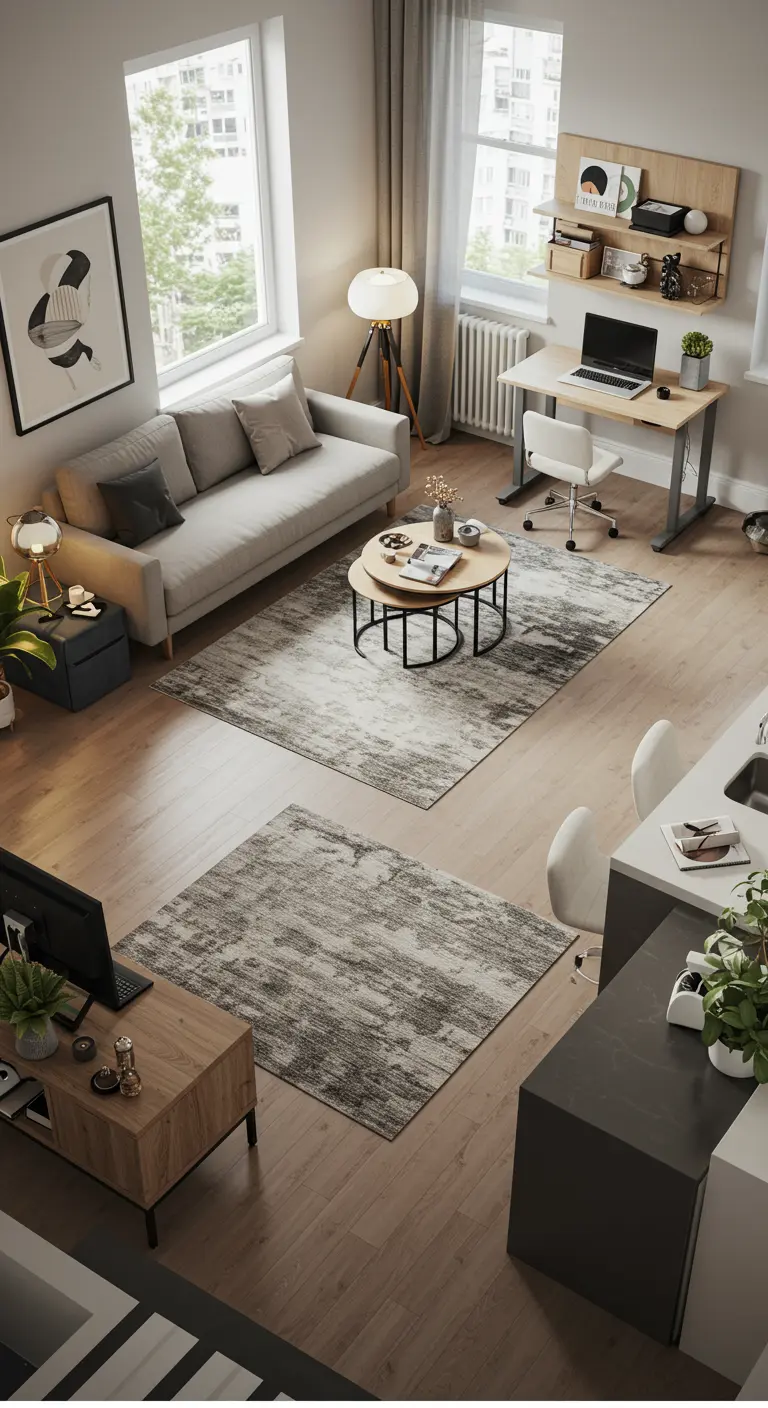
In a large, open-plan room, rugs are your most powerful tool for creating definition.
Use a large rug to anchor the primary seating area, placing the front legs of your sofa and chairs on it to create a cohesive grouping.
Then, use a second, distinct rug to delineate another zone, like a dining area or, in this case, a TV-viewing space. This creates visual separation and a sense of purpose for each area, making the entire room feel more organized and intuitive to navigate.
17. The Library Nook Solution
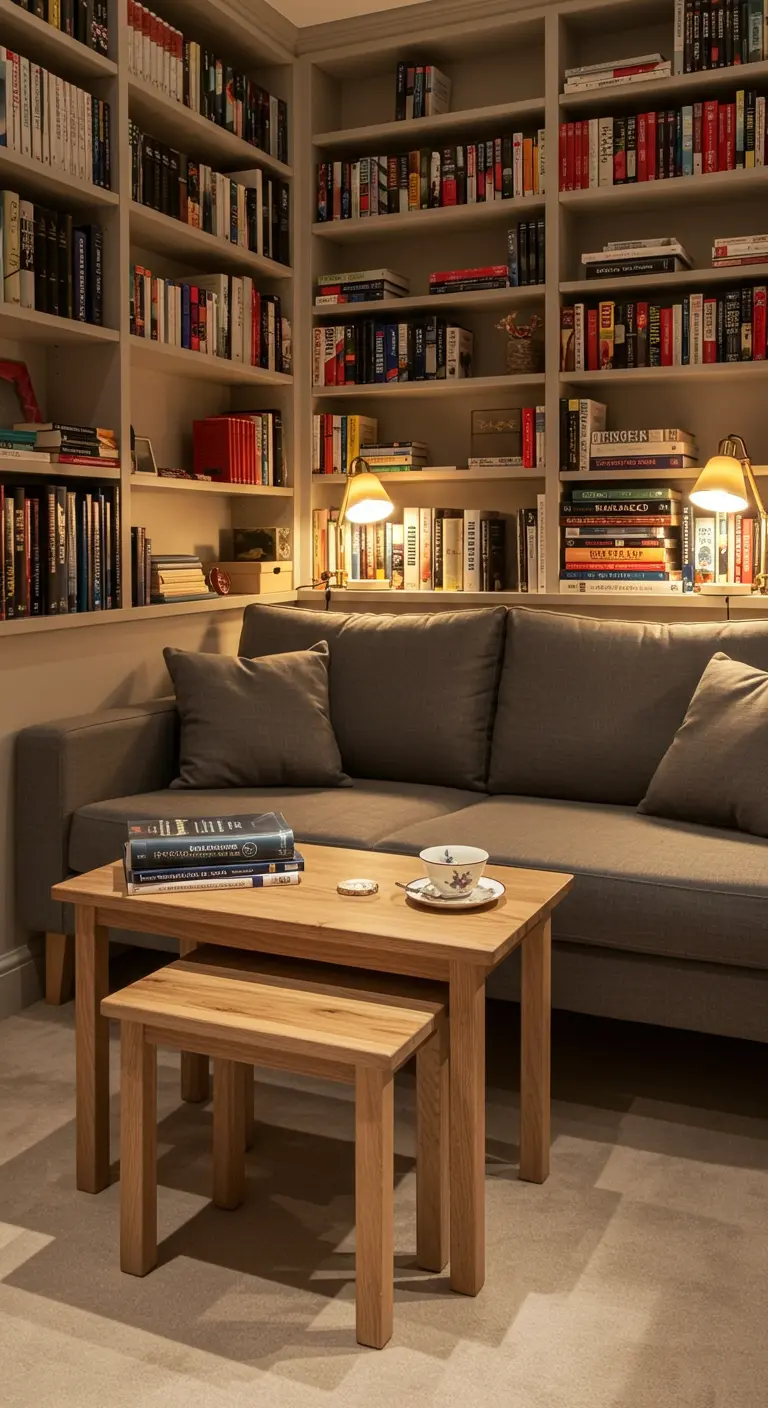
Turn a wall of bookshelves into an inviting reading nook by nestling a sofa directly against it.
This not only saves space but also creates an incredibly cozy, enveloping feeling, reminiscent of an enchanted library.
Opt for nesting tables made of a warm wood to complement the books. They provide a sturdy surface for a cup of tea and a stack of reading material, and the smaller table can be tucked completely away to maximize floor space when not in use.
Targeted lighting from small, warm lamps enhances the intimate atmosphere.
18. The Graphic Power of Monochrome
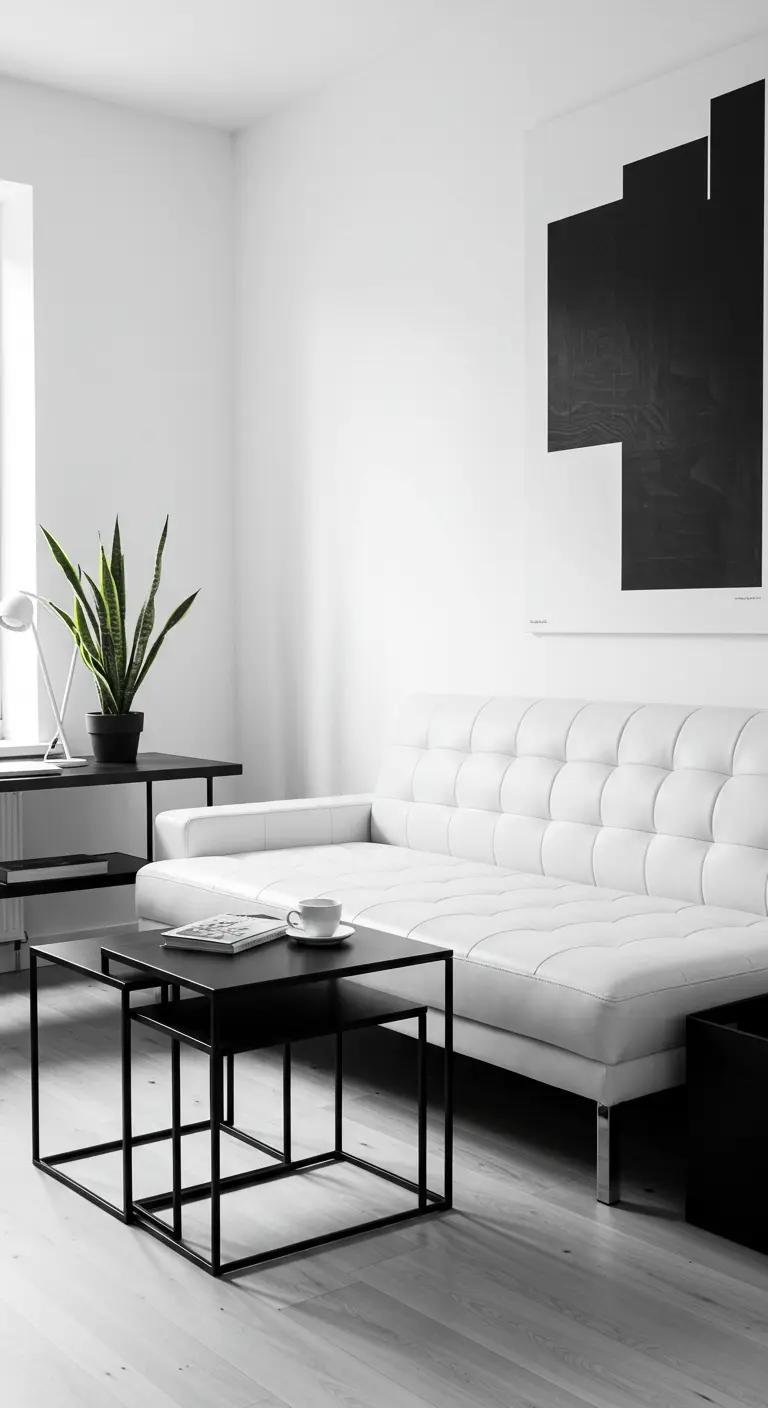
Create a bold, art-gallery feel by committing to a strict black-and-white palette.
A crisp white tufted sofa provides a clean, comfortable canvas. Contrast it sharply with black nesting tables with minimalist frames.
The strong lines of the tables act as a sculptural element, reinforcing the graphic quality of the space.
This high-contrast approach is confident and clean, and it makes the entire room feel curated and intentional. A single green plant adds a vital touch of organic life.
19. The Sweet Simplicity of Pastels

A soft color palette can make a room feel gentle and serene.
This look is beautifully achieved with a mint-green sofa as the main feature.
For a touch of custom charm, give a simple set of wooden nesting tables a DIY update with pastel paint. Here, one is painted a soft lilac and the other a pale green to tie into the decor.
This is an easy, low-cost way to create custom furniture that perfectly matches your vision for a soft, ethereal space.
20. The Over-the-Sofa Workspace
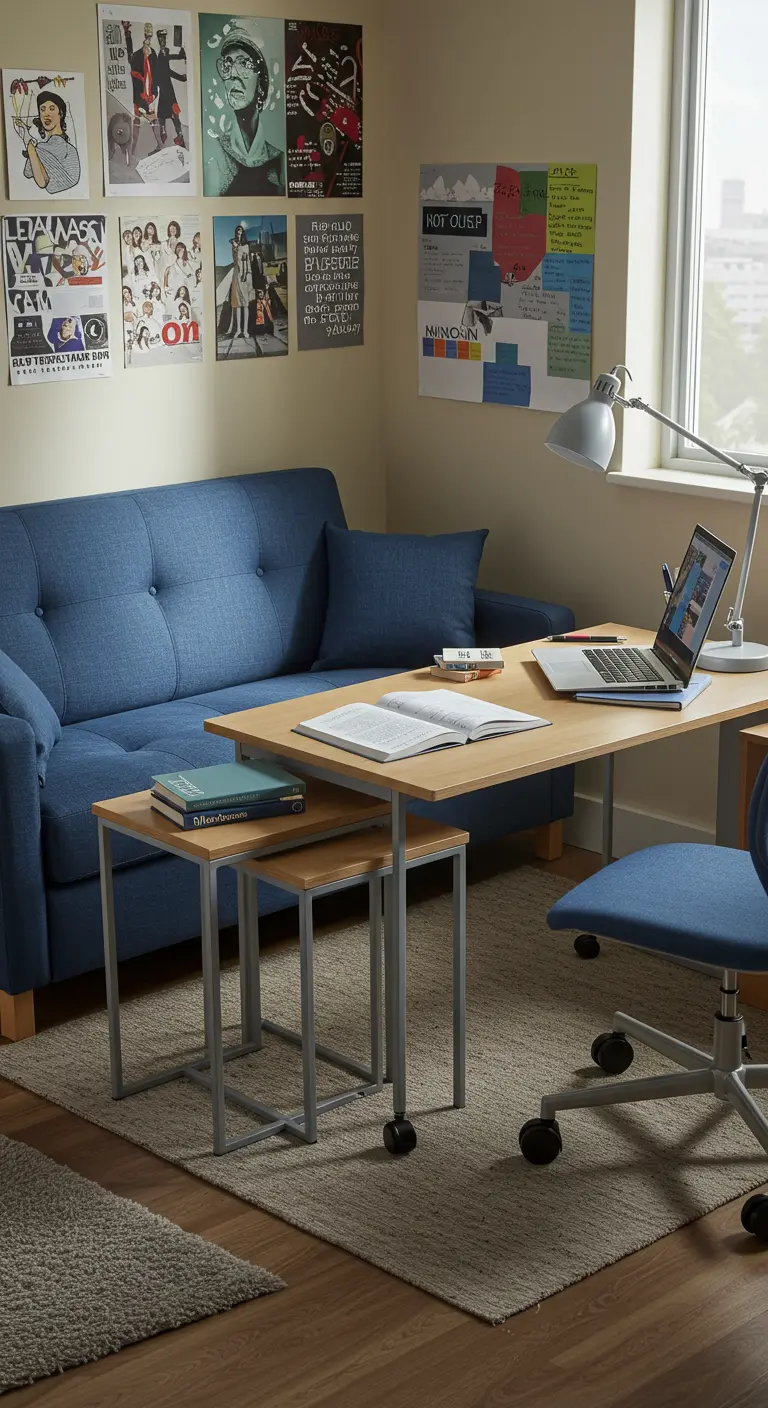
When space is at an absolute premium, your furniture must work harder.
An adjustable-height mobile desk is a game-changer. It can be set at a standard desk height for use with an office chair, or it can be raised and slid over the sofa to create a comfortable work-from-the-couch setup.
This eliminates the need for a dedicated desk footprint entirely.
Nesting tables can be tucked neatly to the side, ready to be deployed for extra surface area as needed. It’s the ultimate in responsive design for small rentals.
21. The Cohesive Rustic Retreat
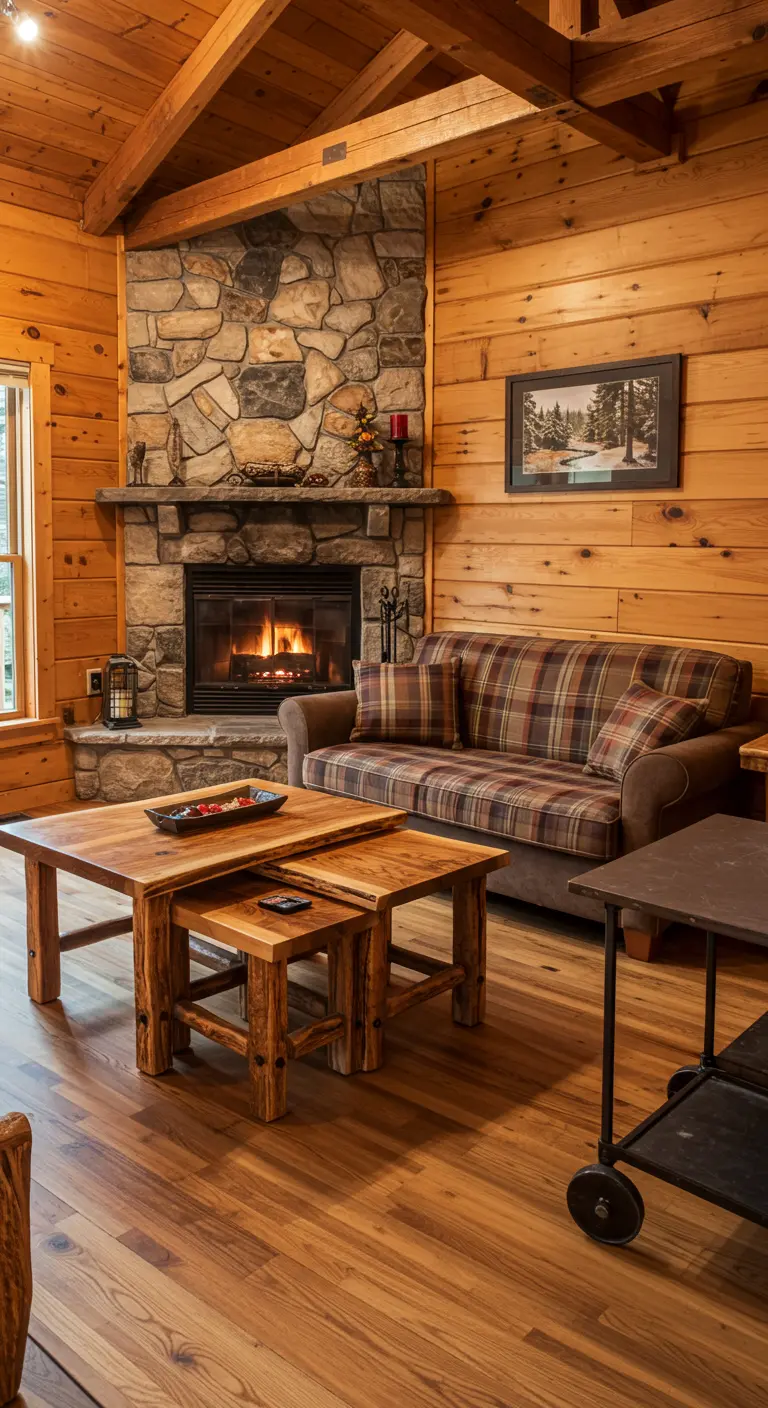
In a room with dominant natural materials like wood paneling and a stone fireplace, your furniture should speak the same language.
Choose pieces made from solid, rustic wood. Chunky nesting coffee tables feel substantial and grounded, echoing the strength of the fireplace.
A plaid sofa adds a layer of classic cabin comfort.
Even the mobile cart is practical and unadorned. This commitment to a consistent material palette creates a harmonious, immersive atmosphere.
22. The Ultimate Integrated Studio
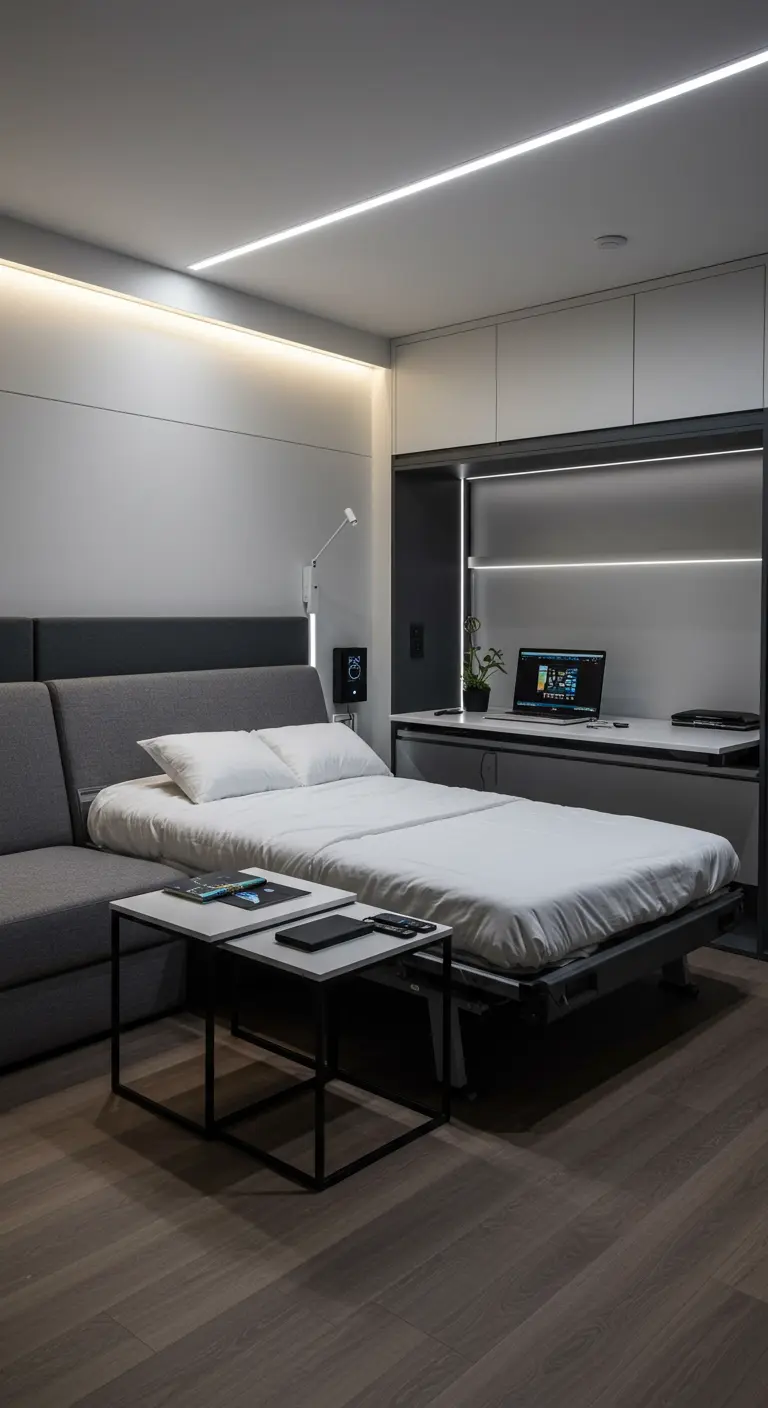
For maximum efficiency in a studio, consider a built-in solution that combines sleeping, lounging, and working.
This modern unit features a sofa that tucks under a pull-down Murphy bed, with an integrated desk and shelving system alongside it.
This all-in-one approach keeps the floor plan incredibly open and uncluttered. Minimalist nesting tables are the only free-floating element, offering a flexible surface that can serve the sofa, bed, or desk area.
Linear LED lighting enhances the clean, contemporary feel.
23. The Warmth of a Tonal Palette
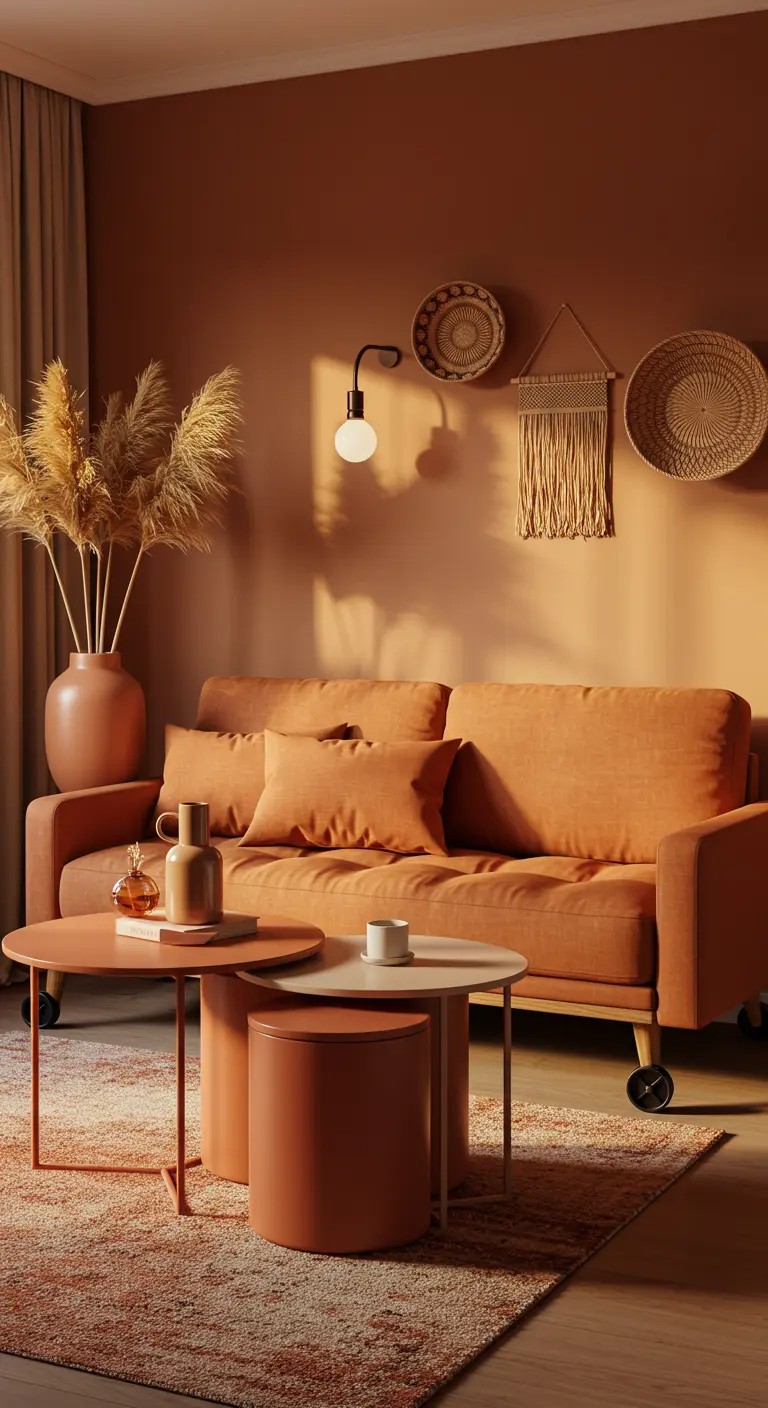
Create a soothing and sophisticated space by layering different shades of the same color family.
This room uses a spectrum of terracotta, from the warm, earthy walls to the slightly lighter sofa and the deeper-toned cylindrical nesting tables.
This monochromatic approach is incredibly calming to the eye and makes the space feel cohesive and thoughtfully designed.
Adding wheels to the sofa is a clever touch, offering an extra layer of flexibility for rearranging the room.
24. Visualizing the Layout from Above
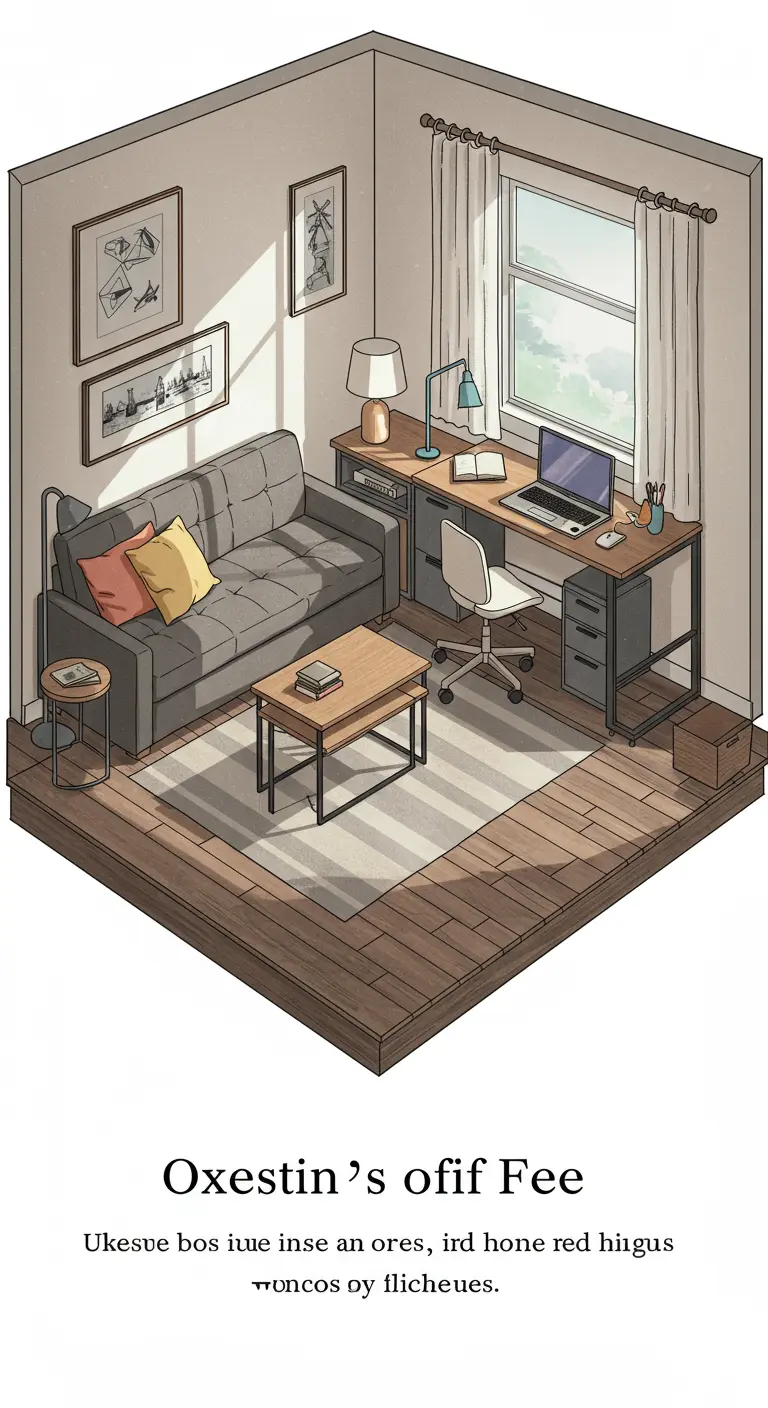
Before you move a single piece of furniture, sketch out your floor plan.
An isometric view like this helps you understand the flow and relationship between pieces. You can see how the rug anchors the seating area, how the desk and chair create a distinct work zone, and how traffic can move easily through the space.
This planning step allows you to identify potential issues—like a cramped walkway or an awkward furniture placement—before you do any heavy lifting. It’s the smartest first step to a successful layout.
25. The Statement-Making Nesting Table
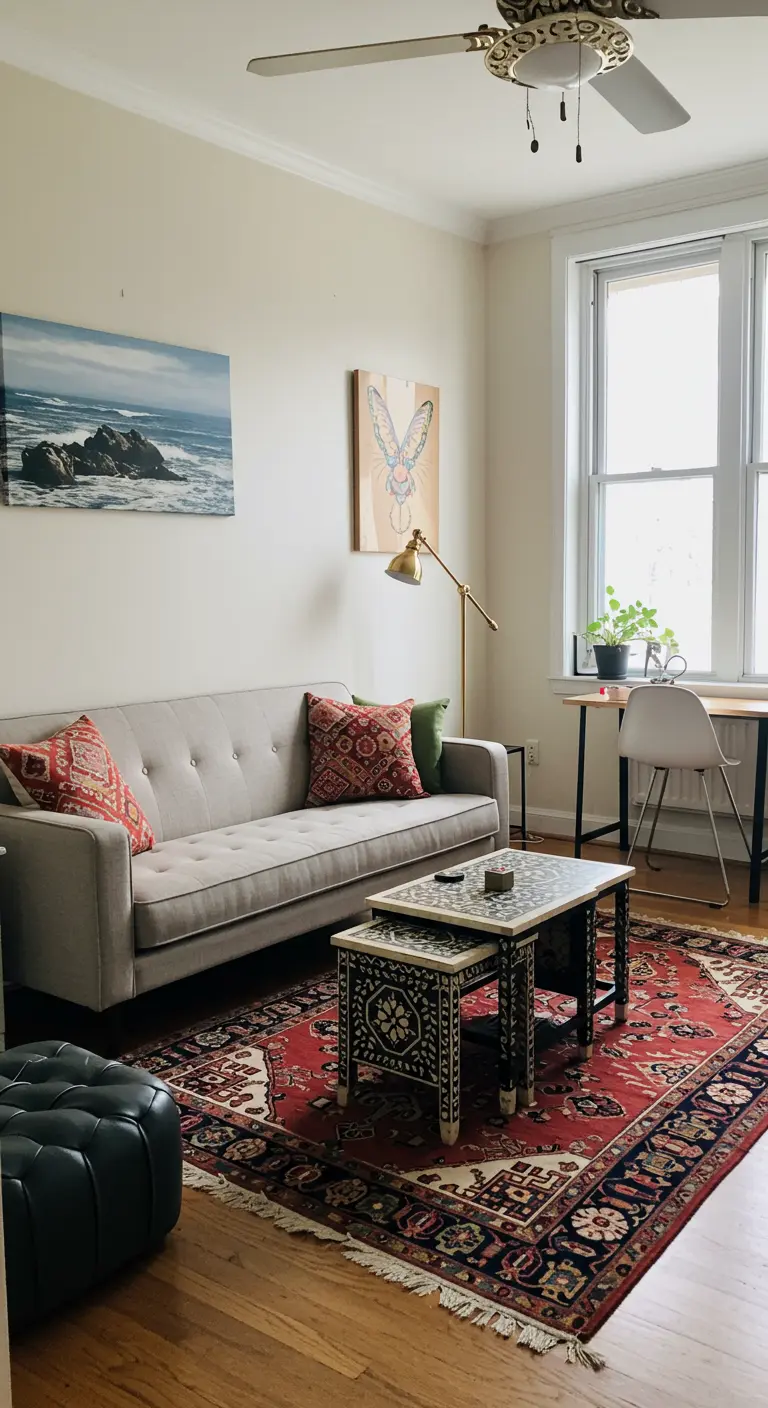
Flexible furniture does not have to be minimalist. Let your nesting tables be a centerpiece.
Here, intricately painted, bone-inlay-style tables bring a dose of global, eclectic charm to the room.
By pairing them with a simple, neutral-colored sofa, you allow the tables to take center stage. This strategy works beautifully: keep your largest, most expensive piece (the sofa) classic and timeless, and introduce personality and trend through smaller, more adaptable items.
26. Inviting Nature In

If your living space opens onto a balcony or garden, your layout should honor that connection.
Choose low-profile furniture, like this olive green sofa and simple wooden nesting tables, that doesn’t obstruct the view or the light. Keep the path to the door clear and uncluttered.
Bringing plants indoors, like the fiddle-leaf fig and hanging ivy, blurs the line between inside and out, making the entire space feel larger and more connected to nature. This is essential for a beautiful balcony garden experience.
27. The Creative Hub Configuration
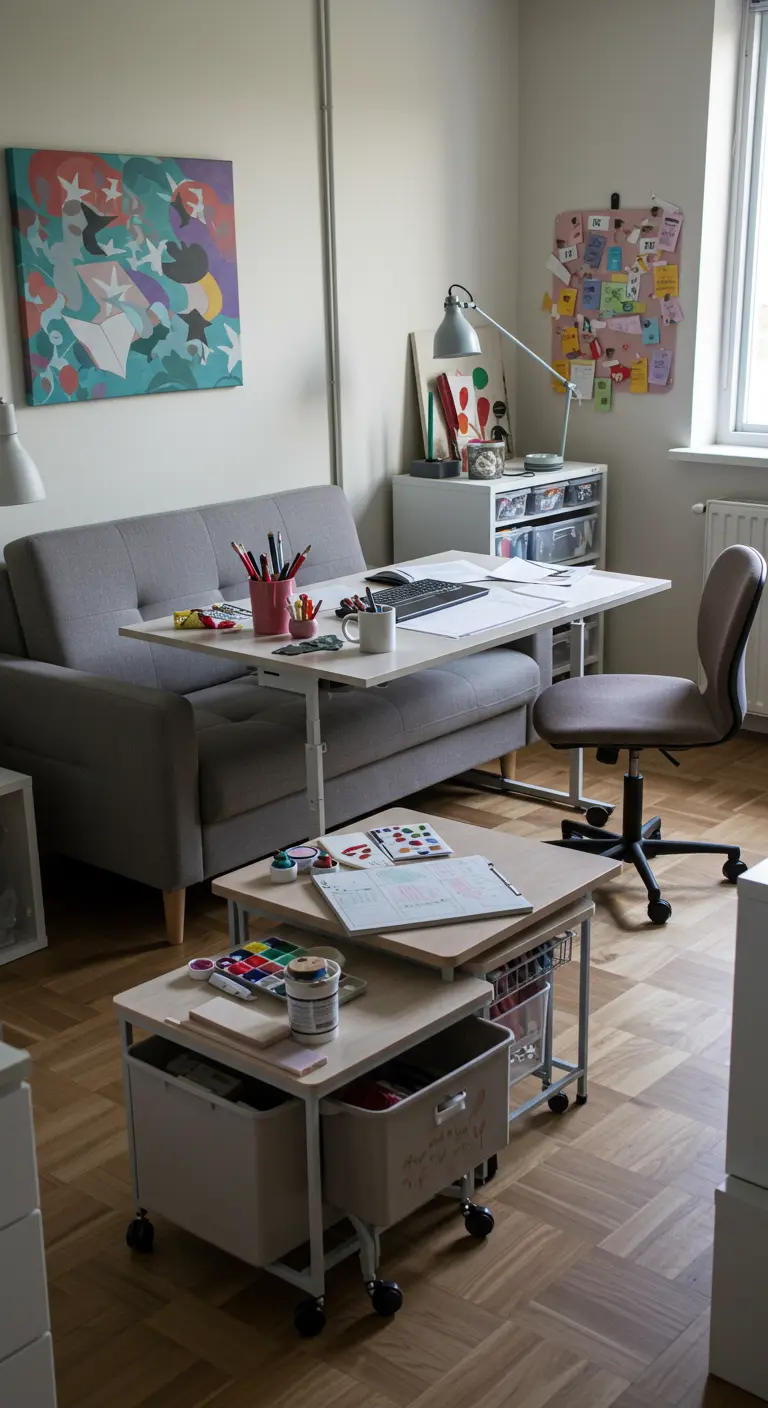
Design a space that works as hard as you do.
An over-sofa desk is a brilliant solution for artists, designers, or anyone who needs a large, accessible work surface without a traditional desk setup.
Complement it with a set of mobile nesting tables that include built-in storage bins. You can roll your supplies exactly where you need them and tuck them away neatly afterwards.
This creates a dynamic, adaptable hub for creativity that can be easily reconfigured for relaxation.
28. The Retro-Modern Mix

Capture a vintage vibe with modern sensibilities by focusing on materials and color.
An olive green corduroy sofa instantly evokes a 70s feel, but its clean lines keep it from looking dated.
Pair it with nesting tables featuring smoked glass tops and chrome bases. This combination of materials is quintessentially retro yet feels incredibly chic and relevant today.
The transparency of the glass keeps the space feeling open, while the dark tint adds a layer of moody sophistication.
29. The Minimalist Studio Apartment
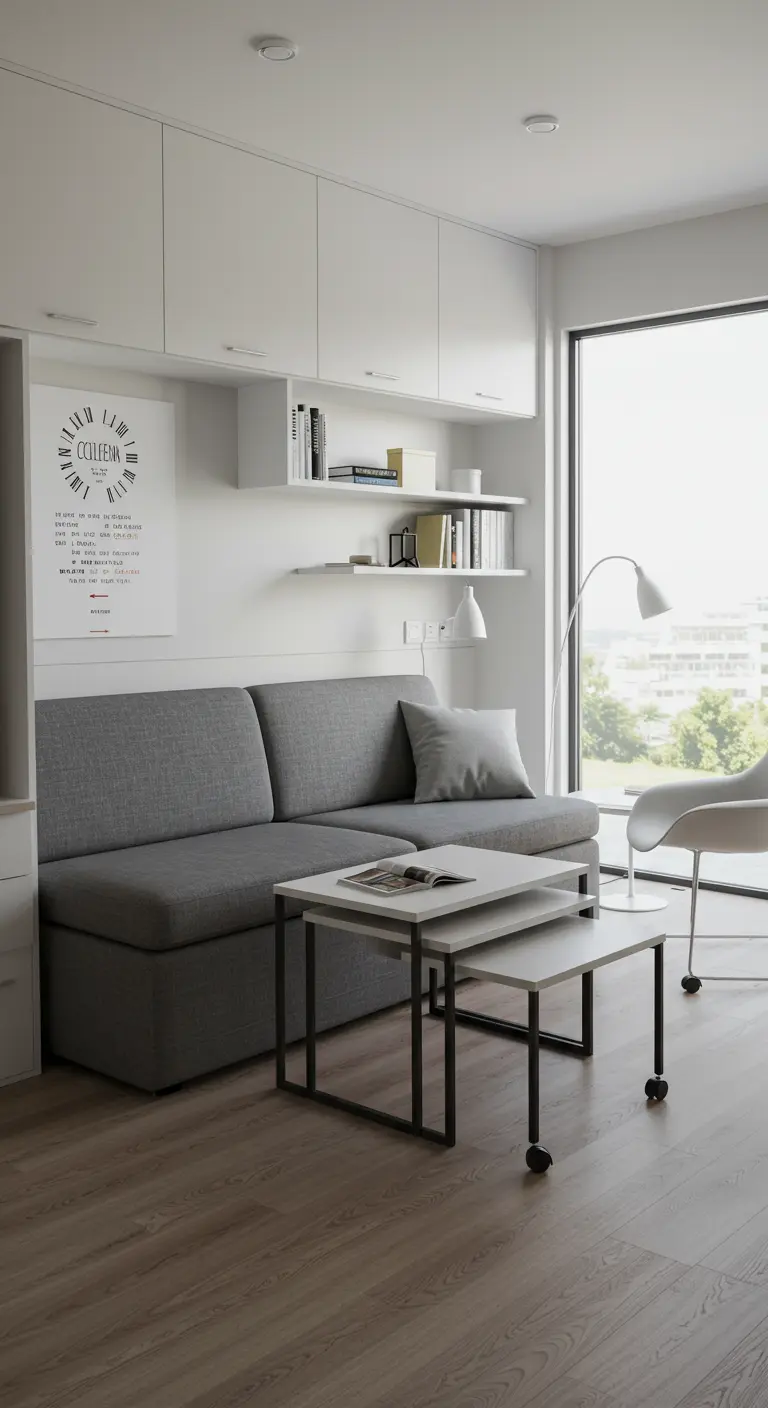
In a studio, every piece must serve multiple purposes. This layout is a masterclass in efficiency.
Wall-to-wall, floor-to-ceiling cabinetry provides ample hidden storage, keeping the living space serene and uncluttered. Floating shelves offer a spot for curated display.
A mobile desk on casters is the most versatile piece, able to function as a workspace, dining table, or console.
Simple, black-framed nesting tables offer additional surfaces that can be moved around as needed. This contemporary zen approach maximizes both function and tranquility.
30. The Bird’s-Eye View of a Flowing Layout
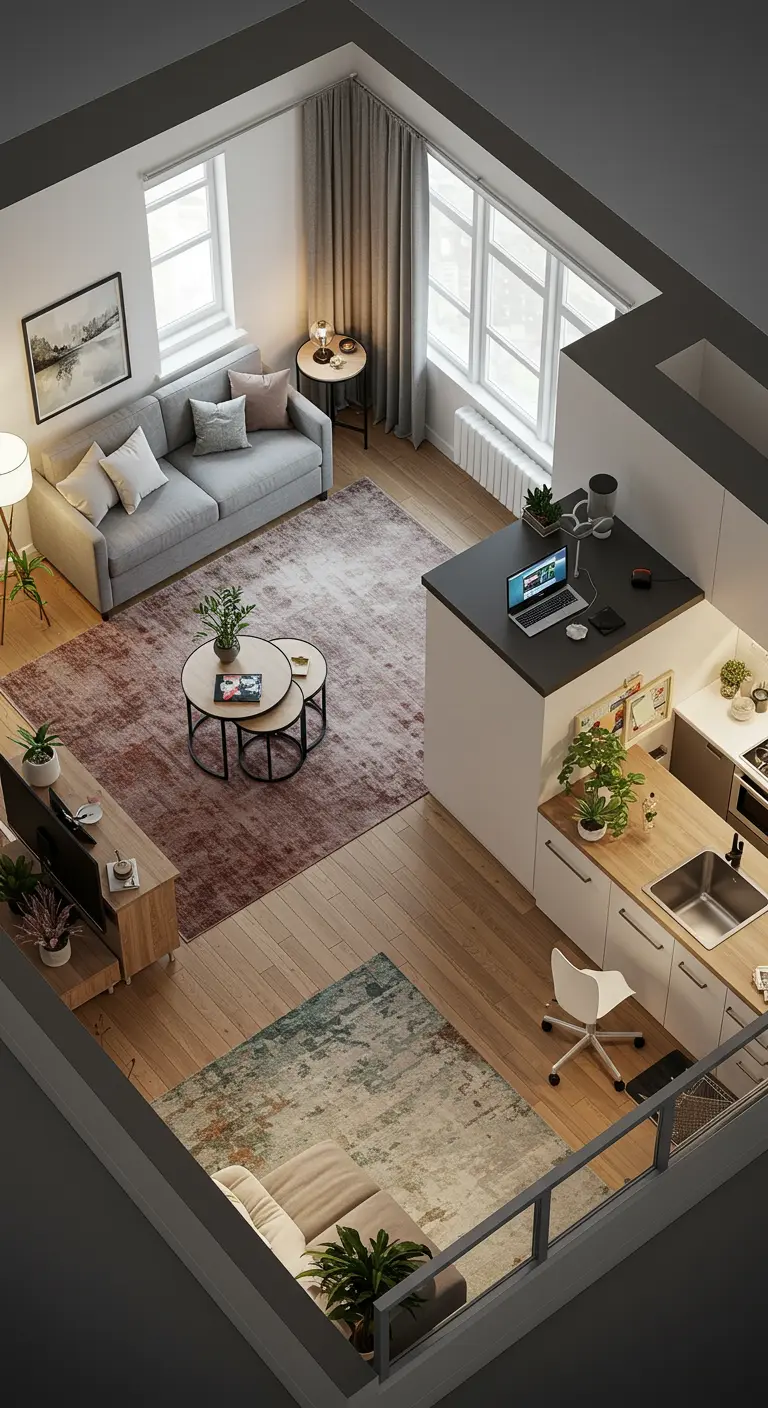
Understanding your home’s layout from above reveals how a space truly functions.
This view shows a masterful use of rugs to create separate zones within an open floor plan. The furniture placement directs a clear path from the entry, around the living area, and toward the kitchen island.
Notice how the sofa acts as a soft barrier, defining the lounge space without a wall.
Planning your layout this way helps you create a home that not only looks beautiful but also feels intuitive and effortless to live in.
